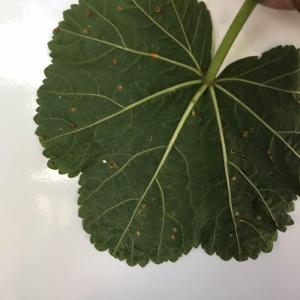Erin Rose
2017年05月28日

I just bought a house and know NOTHING about gardening or taking care of plants. I am trying really hard and would like help identifying these plants so i can research how to take care of them!


















1
0
Mmorrison1005
2017年05月25日

II would love for somebody to be able to tell me what the long skinny plants are.I believe I believe they are kind of weird but I'm not sure they are


2
0
成长记
Chelsea
2017年05月24日
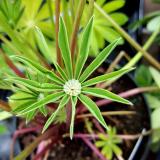
Finally you got roots. After the baby bud. Now time to pot! Plus you are the only survivor of the three poor plants.




2
0
文章
Colorful
2017年05月23日
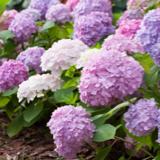
Unique looking succulents can make your rooms look better, also, they are low-maintenance and easiest plants to grow. Check out the 14 best indoor succulents for your home!
Are you looking for the one ingredient that’s capable of making any room look much better? The answer is indoor plants. After the failure of faux plants, indoor houseplants are back in fashion, and why not. A splatter of healthy greenery in your room can make it feel instantly welcoming and fresh. Another good reason to plant indoor plants is they purify air and in turn create a healthier living place.
Also Read: Plants for a Restful Sleep
Now face it, not all houseplants are easy to grow, especially for beginners. However, succulents, when grown as houseplants, adjust well to indoor conditions and are easiest to grow. And that’s why we’ve made a selection of succulents that are popular and easiest to grow.
Also Read: The Most Easy to Grow Houseplants
1. Burro’s Tail (Sedum morganianum)
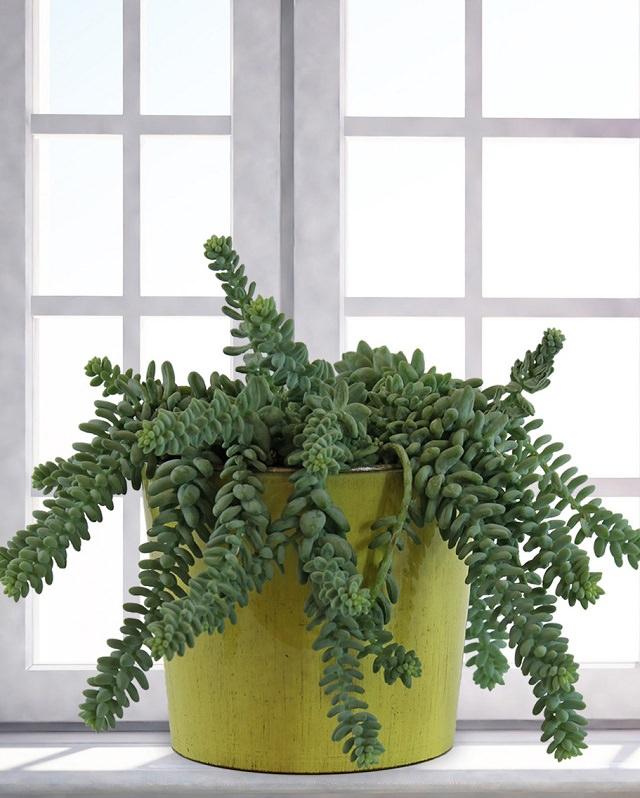
A native of Mexico, Burro’s tail is best planted in hanging baskets due to its fat trailing stems. Its beautiful gray-blue or gray-green leaves can grow up to 2 feet long. This plant does best when kept in a spot that receives bright sun.
Growing TipsLet the soil dry out between watering spells, and ensure that soil is kept on a dry side in times of winter dormancy, especially, if you’re growing it in a cool-temperate zone.Fertilize the plant once in summer using a 10:10:10 fertilizer or any cactus fertilizer.Leaves will fall off with the slightest of touches, so it is important the plant is placed where there will be a minimal disturbance.If you have to move it outside for the summer sun, ensure it will acclimate well before keeping it in a full sun.
2. Zebra Cactus (Haworthia fasciata)

Native to the African continent, the zebra plant perch on top of the soil and sports a neat for of leaves which boasts stunning horizontal white stripes. The beauty of this little plant is that it looks exceptional, takes a small space and requires little to no care.
Growing TipsUse a shallow pot since the roots don’t penetrate the soil deeply.Repot it at the interval of 12-24 months with the fresh succulent potting mix for optimum growth.Allow the soils to nearly dry out between watering spells. It’s important for all the succulents.The zebra plant is best placed in a bright spot so as not to expose the plant to the direct sun lest it becomes shriveled.
3. Aloe vera
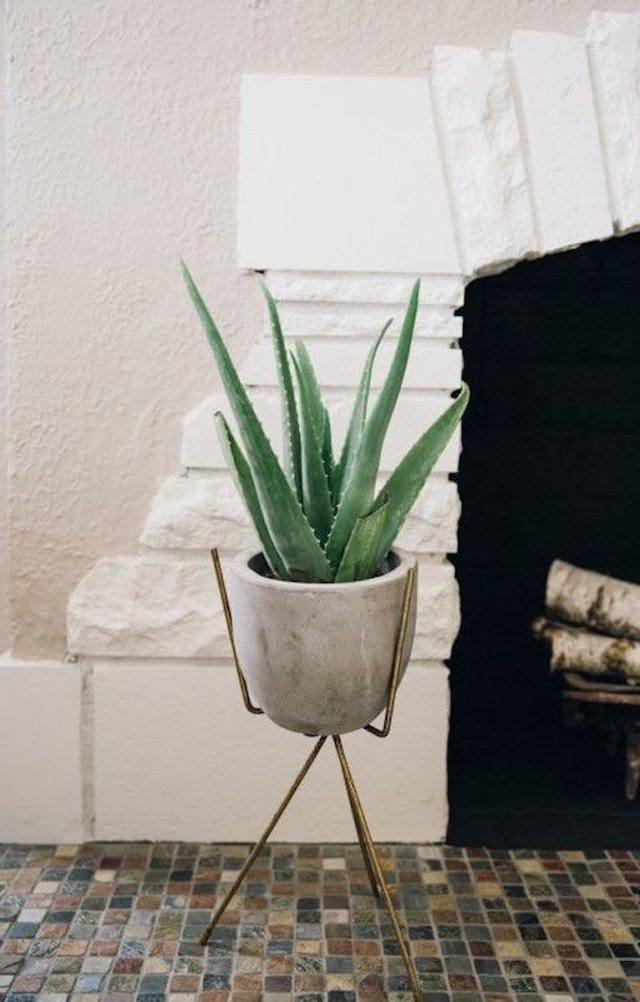
Aloe vera is a medicinal plant, a succulent whose sap has been used to treat sunburn and wounds for centuries. Medicinal value aside, aloe vera is also a great indoor plant. Because the sharp thorns along the margin of the leaves can cut people, the plant is best placed somewhere it can’t be accidentally brushed or fall.
Growing TipsLet the soil dry between soakings.Put it where it can get a couple of hours of sunlight daily.Fertilize the plant twice during the growing season using a balanced 10:10:10 fertilizer but don’t fertilize in winter.Do not repot unless the roots start to push their way out of the pot.
Also Read: How to Care for an Aloe Plants
4. Crown of Thorns (Euphorbia milii)
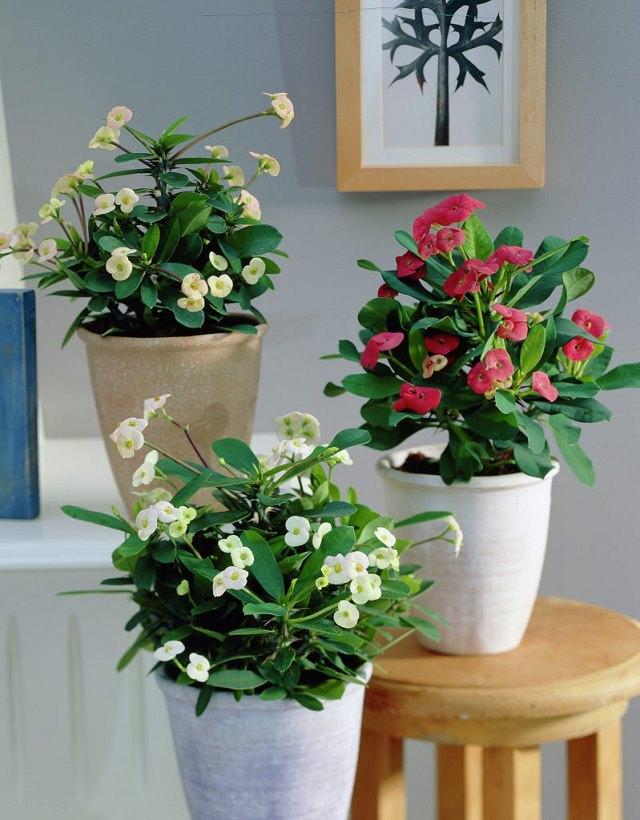
Native to Madagascar, this plant can bloom throughout the year provided you give it enough light. Long and spoon-shaped leaves appear at the end of its spiky branches, together with tiny flowers. The flowers are not noticeable because of their small size, but you will see yellow, red or salmon bracts surround them that looks attractive.
Growing TipsThis plant has low to moderate watering needs.Avoid letting the whole pot dry out or it will drop leaves.Direct light will give you the best bloom although the plant can also adapt to medium-light conditions.Fertilize 2-3 times with a balanced 10:10:10 fertilizer during the growing season.
5. Hens-and-Chicks
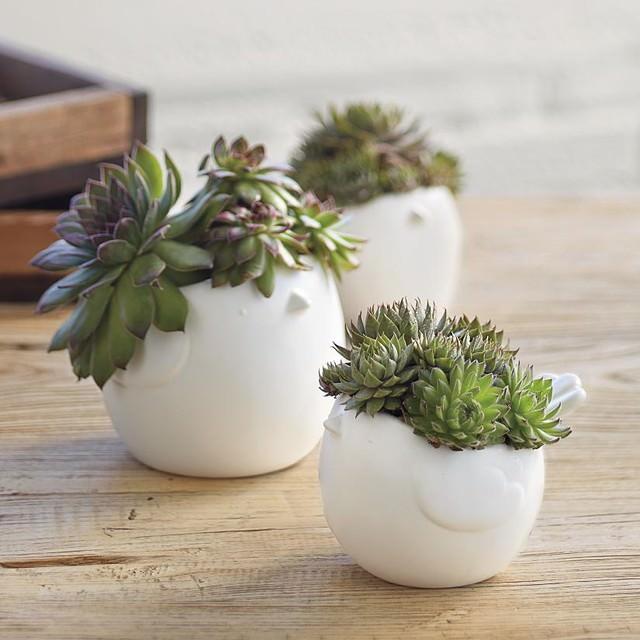
The Hens-and-Chick plants are another great succulent group of plants for indoor gardening, they form flat flowerlike rosettes that have rounded edges. These plants need to be allowed to dry a bit between watering since overwatering can cause rotting.
Growing TipsWater very infrequently during winter dormancy, if growing in a cooler region.Keep these plants in a bright spot, they can also tolerate light shade.You can propagate the plants by cuttings.
6. String of Bananas
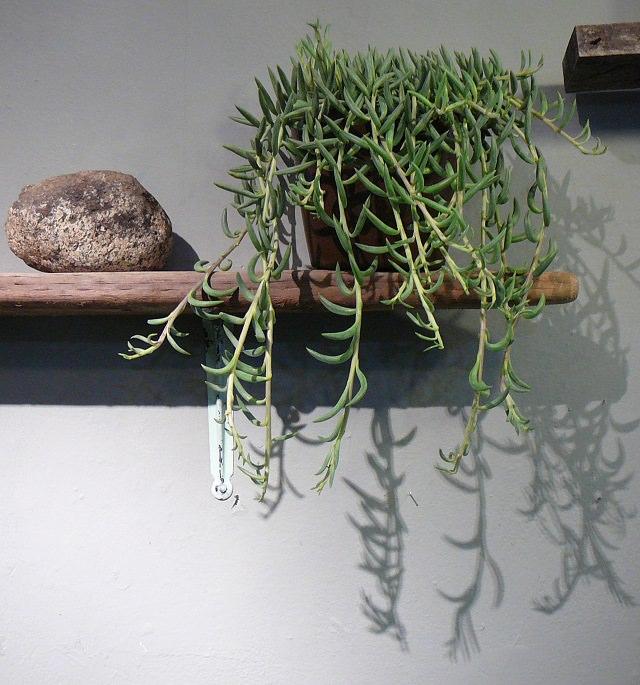
The trailing indoor succulent plant produces long tendrils of small banana-like leaves. The plant looks great when planted on its own and should be pruned regularly to grow thick and full. It also works beautifully when put in a pot containing other succulent indoor plants.
Growing TipsIt requires filtered sunlightWater the plant when soil is dry to touchIt does well in porous soil with excellent drainage.It is toxic, so you need to keep it away from pets and children who might munch it.
7. Lithops

Lithops are unique small and inconspicuous succulent plants that look like stones or pebbles. Growing lithops is very easy and don’t require much care.
Growing TipsKeep the plant in a sunny location, a south or west facing window would be best, away from drafts.Grow lithops in poor, well-drained soil.Stop watering your lithops plants in winter (in cooler zones).
8. Christmas Cactus (Schlumbergera x buckleyi)
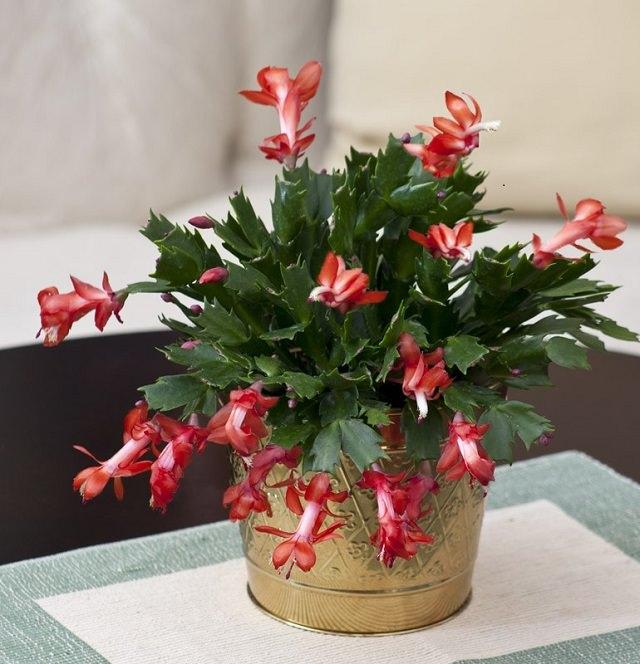
Christmas cactus needs no introduction, it is one of the most beautiful succulent plants, it looks good even without the flowers.
Growing TipsFor this plant to grow, allow the top 2 inches of the soil to dry between watering spells.Keep the plant on a dry side during winter. When it is in bud stage, be very careful since even the slightest overwatering or dehydration can lead to dropping of buds.
9. Ponytail palm (Beaucarnea recurvata)
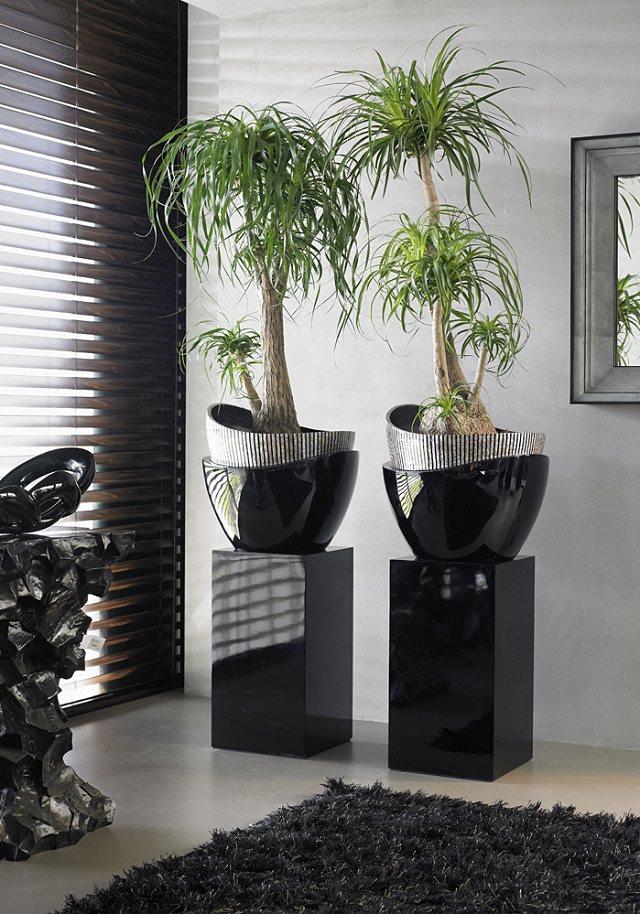
Ponytail palm is not a palm but a succulent. Probably, one of the most appealing houseplants and best in large houseplants. Its water is stored in the swollen stem base, which looks like elephant’s foot that’s why it’s also called “Elephant Foot Palm”.
Growing TipsIt grows well in sunny spots but can be grown in all day long bright indirect sunlight.It’s a plant and forget kind of plant when it comes to watering. Avoid watering regularly and let the top soil dry out before watering again.
10. Snake Plant
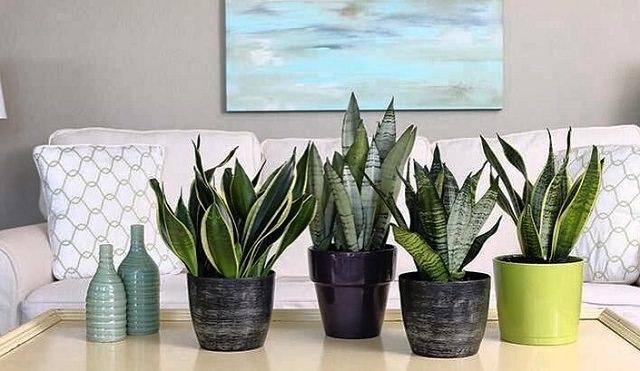
The snake plant or Mother-in-law’s tongue the most low maintenance plant in this list of best succulent plants for indoors and it is well-deserved! We also listed it in our post– Plants You can Grow without Sunlight. And why not, this succulent plant can survive in the darkest of corners and requires very low maintenance.
Growing TipsWater moderately.As snake plant is a very forgiving plant, you can place it in dim spots.
11. String of Pearls

The string of pearls is an exceptional trailing houseplant, very appealing indoors when grown in hanging baskets. You can experiment to grow it in different containers. Like other succulent houseplants growing string of pearls or beads is no different.
Growing TipsKeep the string of pearl plant in a bright light.Be careful with watering, this plant has low watering needs but in warmer regions, moderate watering is required.
12. Panda Plant (Kalanchoe tomentosa)
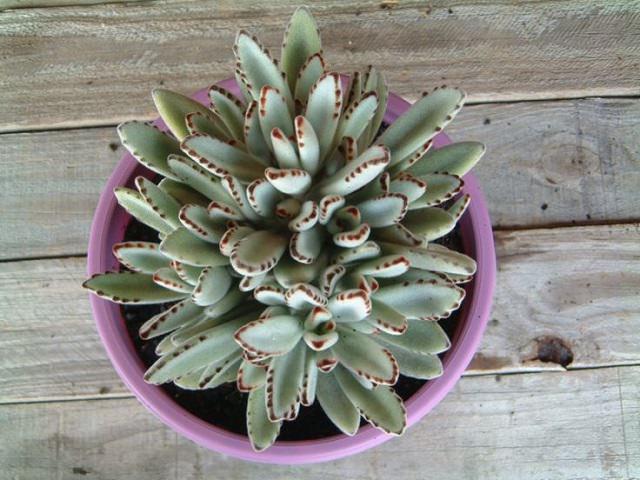
The silver gray hair of this plant makes it look fuzzy, the leaves are fat like other succulents and have rusty color on edges, like many other plants of kalanchoe genus the plant forms flowers too. However, they rarely bloom in indoor conditions.
Growing TipsKeeping the panda plant in a spot that receives bright indirect light and a couple of hours of direct sunlight is a good idea.Water infrequently and let the plant to dry out between the watering spells.Feed the plant once in a month during the growing season.Save the plant from cold and draft, normal room temperature is perfect.
13. Kalanchoe blossfeldiana
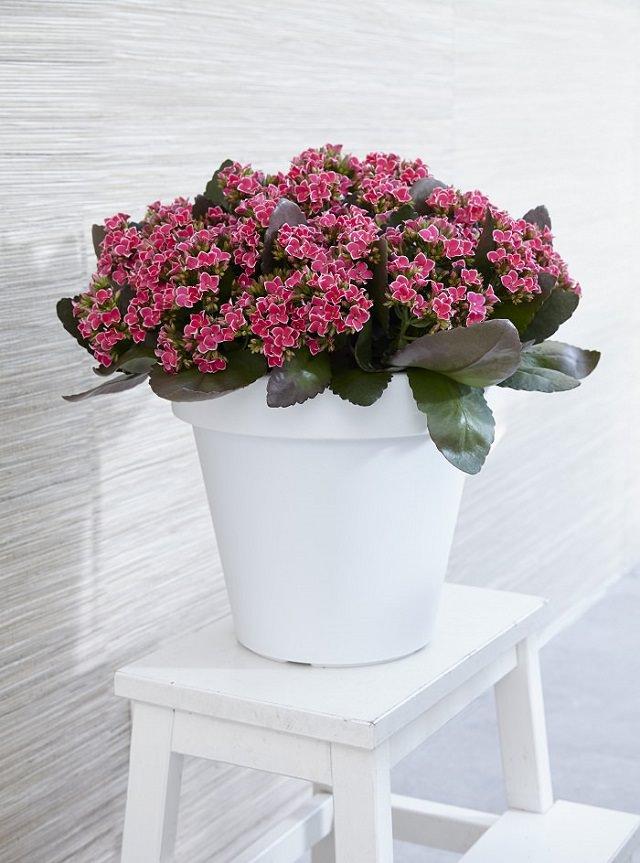
Kalanchoe blossfeldiana is one of the best flowering houseplants you can grow. Plants of this genus grow best outdoors in warm climates. However, it can be grown indoors. This flowering succulent comes in a variety of colors.
Growing TipsLow watering needs.The plant needs to be in a sunny spot to bloom.
Also Read: Flowering Houseplants
14. Pencil Cactus (Euphorbia tirucalli)

Pencil cactus became one of the most popular succulent houseplants from last few years and why not this unique African plant can grow up to 6 feet tall indoors and looks so different, quite a few houseplants like fiddle leaf fig can achieve such height.
Growing TipsKeep the plant near a sunny window.Water every couple of weeks, the plant has low watering needs.Use well-drained, gritty soil.Repot the plant every year or when you find it rootbound.
Are you looking for the one ingredient that’s capable of making any room look much better? The answer is indoor plants. After the failure of faux plants, indoor houseplants are back in fashion, and why not. A splatter of healthy greenery in your room can make it feel instantly welcoming and fresh. Another good reason to plant indoor plants is they purify air and in turn create a healthier living place.
Also Read: Plants for a Restful Sleep
Now face it, not all houseplants are easy to grow, especially for beginners. However, succulents, when grown as houseplants, adjust well to indoor conditions and are easiest to grow. And that’s why we’ve made a selection of succulents that are popular and easiest to grow.
Also Read: The Most Easy to Grow Houseplants
1. Burro’s Tail (Sedum morganianum)

A native of Mexico, Burro’s tail is best planted in hanging baskets due to its fat trailing stems. Its beautiful gray-blue or gray-green leaves can grow up to 2 feet long. This plant does best when kept in a spot that receives bright sun.
Growing TipsLet the soil dry out between watering spells, and ensure that soil is kept on a dry side in times of winter dormancy, especially, if you’re growing it in a cool-temperate zone.Fertilize the plant once in summer using a 10:10:10 fertilizer or any cactus fertilizer.Leaves will fall off with the slightest of touches, so it is important the plant is placed where there will be a minimal disturbance.If you have to move it outside for the summer sun, ensure it will acclimate well before keeping it in a full sun.
2. Zebra Cactus (Haworthia fasciata)

Native to the African continent, the zebra plant perch on top of the soil and sports a neat for of leaves which boasts stunning horizontal white stripes. The beauty of this little plant is that it looks exceptional, takes a small space and requires little to no care.
Growing TipsUse a shallow pot since the roots don’t penetrate the soil deeply.Repot it at the interval of 12-24 months with the fresh succulent potting mix for optimum growth.Allow the soils to nearly dry out between watering spells. It’s important for all the succulents.The zebra plant is best placed in a bright spot so as not to expose the plant to the direct sun lest it becomes shriveled.
3. Aloe vera

Aloe vera is a medicinal plant, a succulent whose sap has been used to treat sunburn and wounds for centuries. Medicinal value aside, aloe vera is also a great indoor plant. Because the sharp thorns along the margin of the leaves can cut people, the plant is best placed somewhere it can’t be accidentally brushed or fall.
Growing TipsLet the soil dry between soakings.Put it where it can get a couple of hours of sunlight daily.Fertilize the plant twice during the growing season using a balanced 10:10:10 fertilizer but don’t fertilize in winter.Do not repot unless the roots start to push their way out of the pot.
Also Read: How to Care for an Aloe Plants
4. Crown of Thorns (Euphorbia milii)

Native to Madagascar, this plant can bloom throughout the year provided you give it enough light. Long and spoon-shaped leaves appear at the end of its spiky branches, together with tiny flowers. The flowers are not noticeable because of their small size, but you will see yellow, red or salmon bracts surround them that looks attractive.
Growing TipsThis plant has low to moderate watering needs.Avoid letting the whole pot dry out or it will drop leaves.Direct light will give you the best bloom although the plant can also adapt to medium-light conditions.Fertilize 2-3 times with a balanced 10:10:10 fertilizer during the growing season.
5. Hens-and-Chicks

The Hens-and-Chick plants are another great succulent group of plants for indoor gardening, they form flat flowerlike rosettes that have rounded edges. These plants need to be allowed to dry a bit between watering since overwatering can cause rotting.
Growing TipsWater very infrequently during winter dormancy, if growing in a cooler region.Keep these plants in a bright spot, they can also tolerate light shade.You can propagate the plants by cuttings.
6. String of Bananas

The trailing indoor succulent plant produces long tendrils of small banana-like leaves. The plant looks great when planted on its own and should be pruned regularly to grow thick and full. It also works beautifully when put in a pot containing other succulent indoor plants.
Growing TipsIt requires filtered sunlightWater the plant when soil is dry to touchIt does well in porous soil with excellent drainage.It is toxic, so you need to keep it away from pets and children who might munch it.
7. Lithops

Lithops are unique small and inconspicuous succulent plants that look like stones or pebbles. Growing lithops is very easy and don’t require much care.
Growing TipsKeep the plant in a sunny location, a south or west facing window would be best, away from drafts.Grow lithops in poor, well-drained soil.Stop watering your lithops plants in winter (in cooler zones).
8. Christmas Cactus (Schlumbergera x buckleyi)

Christmas cactus needs no introduction, it is one of the most beautiful succulent plants, it looks good even without the flowers.
Growing TipsFor this plant to grow, allow the top 2 inches of the soil to dry between watering spells.Keep the plant on a dry side during winter. When it is in bud stage, be very careful since even the slightest overwatering or dehydration can lead to dropping of buds.
9. Ponytail palm (Beaucarnea recurvata)

Ponytail palm is not a palm but a succulent. Probably, one of the most appealing houseplants and best in large houseplants. Its water is stored in the swollen stem base, which looks like elephant’s foot that’s why it’s also called “Elephant Foot Palm”.
Growing TipsIt grows well in sunny spots but can be grown in all day long bright indirect sunlight.It’s a plant and forget kind of plant when it comes to watering. Avoid watering regularly and let the top soil dry out before watering again.
10. Snake Plant

The snake plant or Mother-in-law’s tongue the most low maintenance plant in this list of best succulent plants for indoors and it is well-deserved! We also listed it in our post– Plants You can Grow without Sunlight. And why not, this succulent plant can survive in the darkest of corners and requires very low maintenance.
Growing TipsWater moderately.As snake plant is a very forgiving plant, you can place it in dim spots.
11. String of Pearls

The string of pearls is an exceptional trailing houseplant, very appealing indoors when grown in hanging baskets. You can experiment to grow it in different containers. Like other succulent houseplants growing string of pearls or beads is no different.
Growing TipsKeep the string of pearl plant in a bright light.Be careful with watering, this plant has low watering needs but in warmer regions, moderate watering is required.
12. Panda Plant (Kalanchoe tomentosa)

The silver gray hair of this plant makes it look fuzzy, the leaves are fat like other succulents and have rusty color on edges, like many other plants of kalanchoe genus the plant forms flowers too. However, they rarely bloom in indoor conditions.
Growing TipsKeeping the panda plant in a spot that receives bright indirect light and a couple of hours of direct sunlight is a good idea.Water infrequently and let the plant to dry out between the watering spells.Feed the plant once in a month during the growing season.Save the plant from cold and draft, normal room temperature is perfect.
13. Kalanchoe blossfeldiana

Kalanchoe blossfeldiana is one of the best flowering houseplants you can grow. Plants of this genus grow best outdoors in warm climates. However, it can be grown indoors. This flowering succulent comes in a variety of colors.
Growing TipsLow watering needs.The plant needs to be in a sunny spot to bloom.
Also Read: Flowering Houseplants
14. Pencil Cactus (Euphorbia tirucalli)

Pencil cactus became one of the most popular succulent houseplants from last few years and why not this unique African plant can grow up to 6 feet tall indoors and looks so different, quite a few houseplants like fiddle leaf fig can achieve such height.
Growing TipsKeep the plant near a sunny window.Water every couple of weeks, the plant has low watering needs.Use well-drained, gritty soil.Repot the plant every year or when you find it rootbound.
8
9
文章
Gina
2017年05月23日
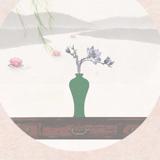
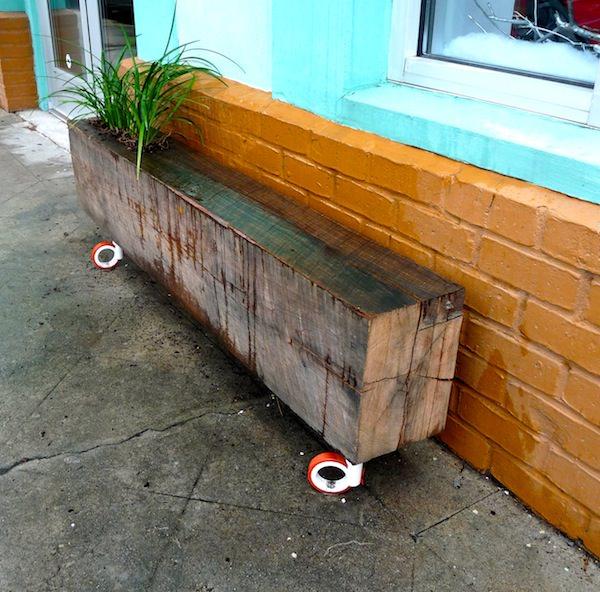
Plant your furniture…literally! We have run across these really neat ways to integrate plantings into your garden rooms, by planting your furniture itself! Really unique containers, and I love the idea of having plants as part of the outdoor room, not just next to it. Some of these have some easy DIY instructions, and others are just inspirational to get your creative ideas flowing… but they are all great ideas for any garden seating area. Remember, you can always alter a tutorial to fit your style and needs… love the chair planter, but it’s too cottage for you? Plant a simpler chair with succulents, or all foliage plants for a more minimalistic look. Use moss, or succulents, or try using all one type of flower in a project instead of a mix. I actually love the simple green of the modern table with the grass… the deep green color also brings out the amazing wood the table is made of… Remember, if you decide to go it alone, and dive into creating a planter out of furniture, you must either accept that the weathering of the water and plants will eventually rot away the piece, or you must provide a moisture barrier to protect the furniture. This can be as simple as attaching some plastic sheeting with a staple gun. Remember, the thrift store and yard sales are your friend here. So here are our picks for planting your furniture, send us pics and share your projects readers!
Our featured project, above, from HomeJelly is one of my favorites, and simple enough for anyone… Its a ceiling beam planter bench, and has a complete tutorial. All you need for this is a drill, a chisel, and wheels if you want it to be movable…You could also do this with railroad ties, but I would worry about seeping creosote myself… Don’t forget to read their safety advice! Want a similar, upscale look? Tao Concrete on Etsy sells this version. We could see this being DIY’able as well.
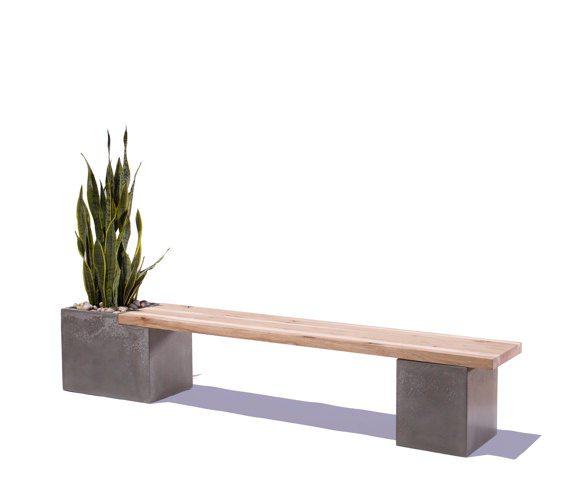
From HGTV, this dresser planter is an easy one…just remember to line the drawers before you fill with soil if you want to preserve the wood. You could use the top as a serving buffet!
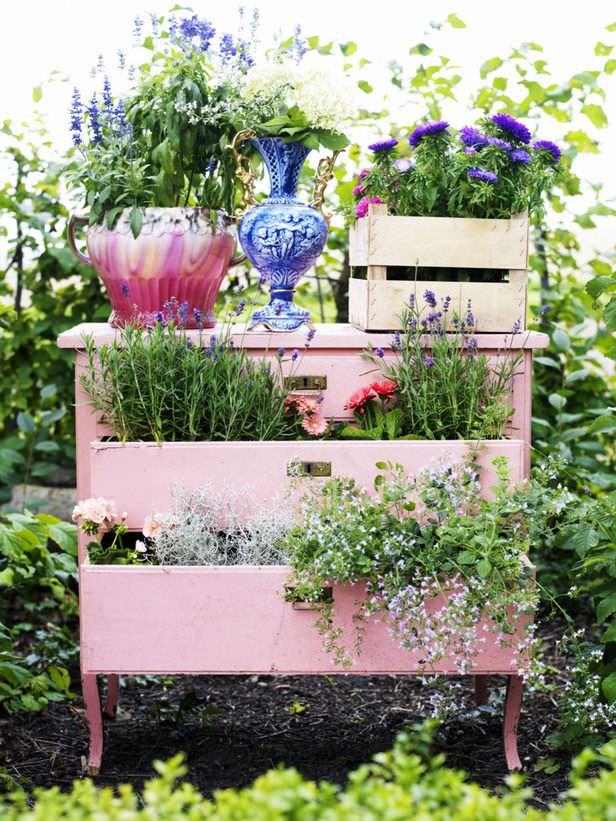
FromKatie Jackson Woodworks on Instructables, this Reclaimed Wood Flat Pack Picnic Table With Planter is pretty cool… you can use the center trough for ice and drinks, or plant herbs, pretty lettuce or edible flowers. This design is an award winner as well!
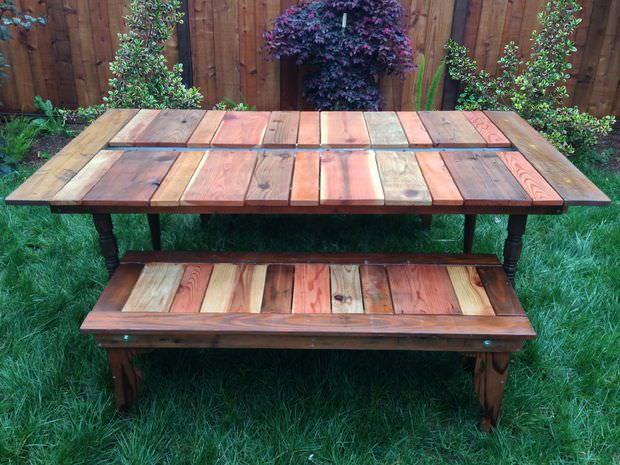
From This Old House, this hypertufa planter table is clearly amazing… and the hypertufa is so much lighter and stronger than concrete. Great instructions for this project, and even a video.
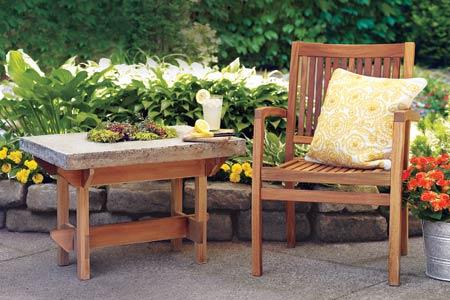
Since we are on hypertufa, Lowes has this step by step for this hypertufa planter table as well, and this might be a better beginner project. So cute!
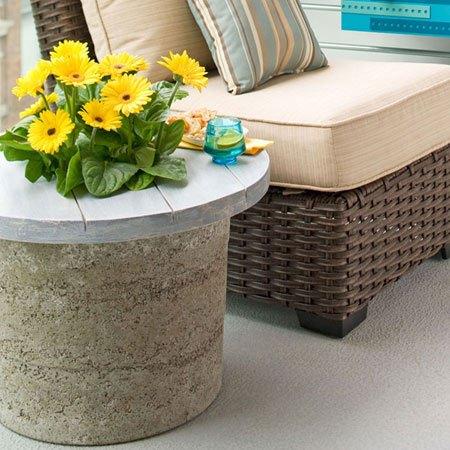
Cactus Jungle took the hypertufa table idea, created two troughs and used succulents. Cool!
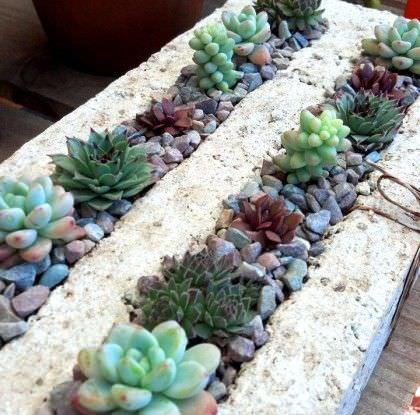
From Libby James, and totally inspirational, this is the modern table I talked about in my intro… This. Is. Cool.
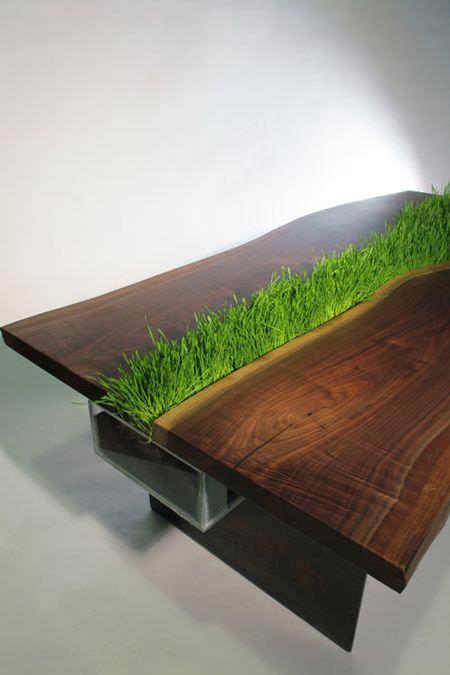
From Four Generations, One Roof, we love this DIY chair planter. Color, not too cute but fun and fresh! Don’t forget to check out her complete tutorial.
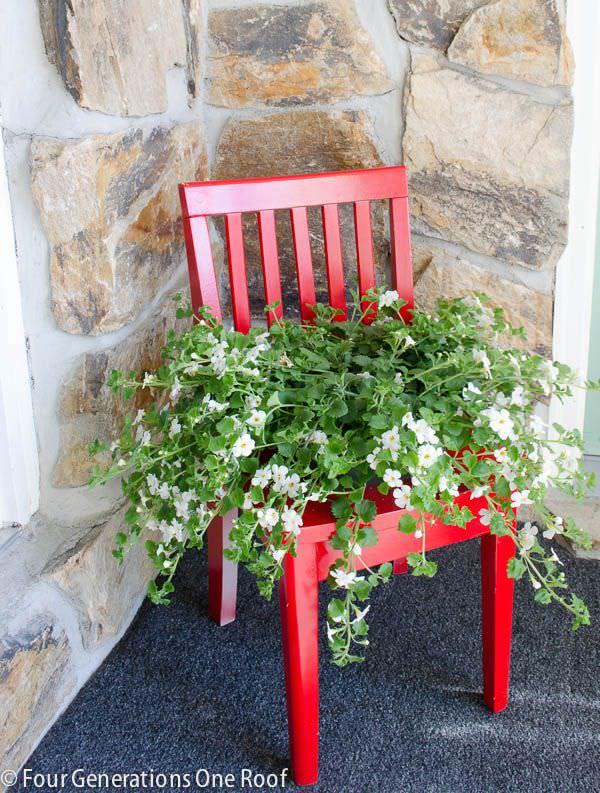
This tin bathtub planter table is great inspiration… This photo is by Hammers and High Heels from Bachmans in Minneapolis… This would be an easy DIY folks!
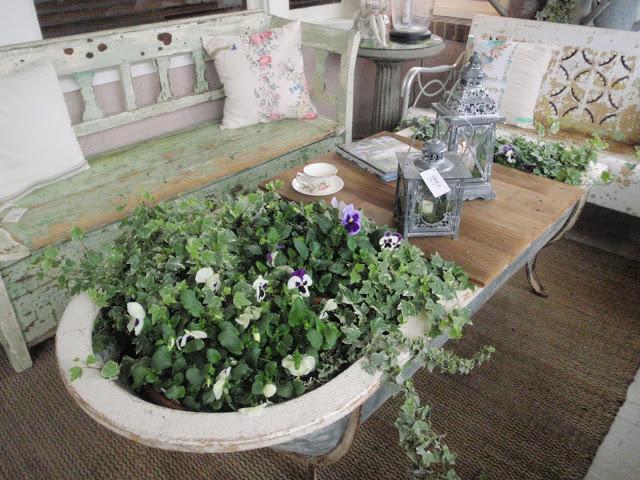
Who needs lighting? This DIY chandelier planter by DIY Show Off will make your outdoor room glow all by itself! Follow her step by step instructions to find our how to take your thrift store (or basement) find and turn it into garden treasure. (BTW, this project was featured by BHG!)
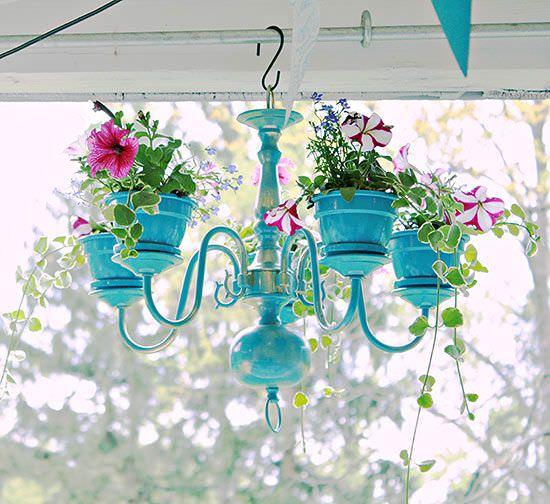
Purely inspirational, we found this photo on Pinterest, and I would love to have this whimsical piece in a corner of my garden! I would think you could DIY this with some chicken wire, a staple gun and some patience. If anyone knows who created this marvelous piece, please let us know, we’d like to pick their brain!
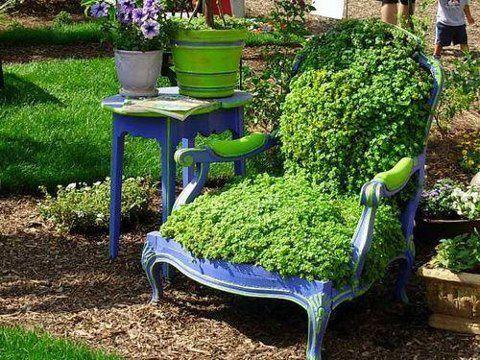
The blog that originally posted this idea no longer exists, but I had to include it… Again, staple gun, some soil, and some moss is all it would take. Remember if you use moss that it requires shade and water… There are some sedums now that have find texture that would give you the same look for sunnier and drier gardens. Sedum “Acre” would be great choice, and has tiny yellow flowers in summer.
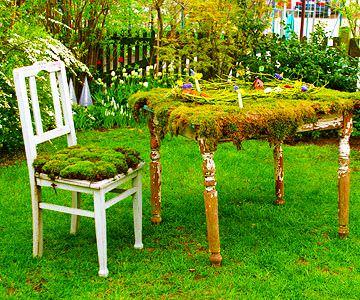
An engineering gardener created this planter table form an old door, and some hairpin table legs. Amazing ingenuity!
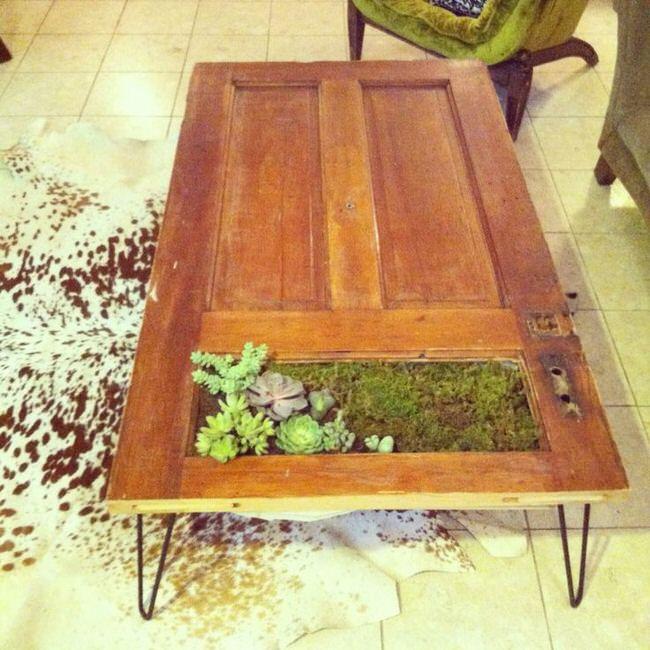
A lot of mid-century furniture was designed with planters, it was part of the theory behind the modern movement to integrate nature in design. Keep your eye out for pieces like this at yard and estate sales, and don’t be afraid to press them into use outdoors in a covered or protected area.

And this one from ModAttic…

Lastly, this DIY coffee table with built in planter from Shelterness… Good instructions, easy project…

2
0
文章
Colorful
2017年05月23日

The houseplants in this list are exceptional; they are bold and pretty. Some of the most unique, beautiful indoor plants you should grow!Grow some of these plants indoors, and you’ll see a big change in your interior. These beautiful houseplants have the ability to change the appearance of any dull-boring room!1. Nerve Plant
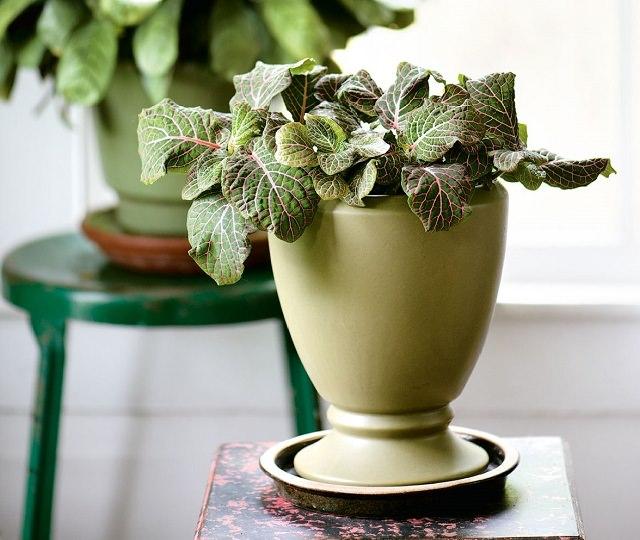
This demanding houseplant looks gorgeous due to its striking leaves. Picky about watering and dry indoor air and cold drafts. You must need to keep balance in watering.
2. Croton
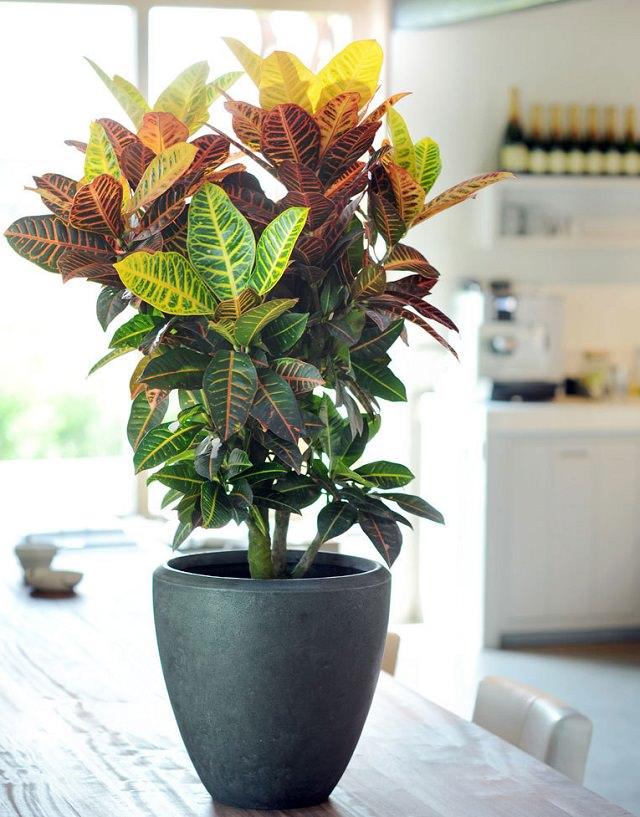
The bold and bodacious houseplant that is low maintenance too. The mix of yellow, amber, and orange color linear markings on thick dark green foliage, croton looks stunning. To grow, keep it in a spot that receives bright indirect light most of the time and water sporadically.
3. Calathea
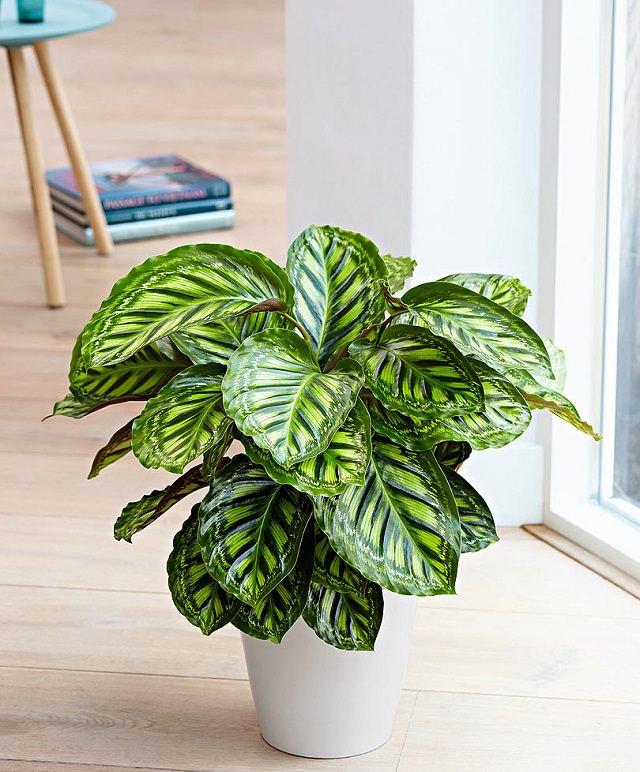
Lovely plant, great to look at! Many varieties are available in astonishing color combinations and patterns. This tropical houseplant doesn’t mind low light conditions. Keep it in warm, normal room temperature, saving from cold drafts. It likes humid surroundings and moderate watering.
4. Pencil Cactus
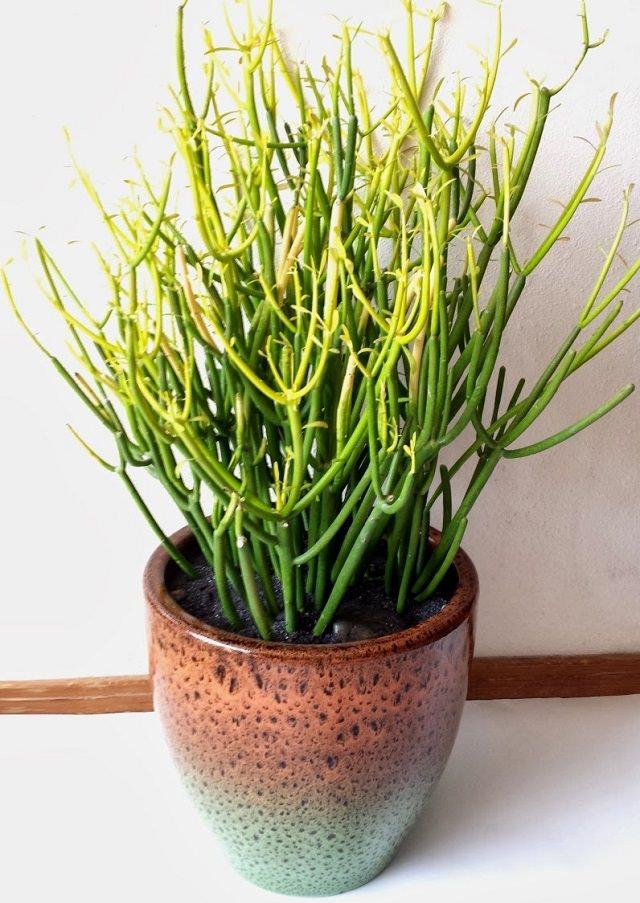
This unusual looking astonishing plant is notorious for its toxic milky sap (take care when handling this plant); still, it’s getting popular as a houseplant. Pencil cactus has medium to high light requirements and low watering needs; it also doesn’t mind dry air. Watering 2-3 times in a month is sufficient. To grow, keep the plant in a spot with ample light, a shaft of sunlight for a few hours or even more and it would do fine.
5. Silver Vase Plant
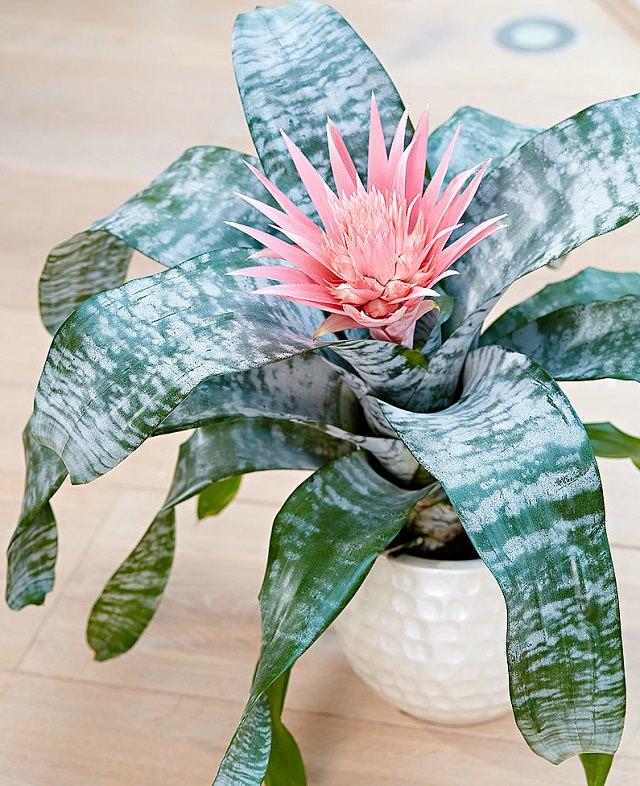
Unusual but a beautiful indoor plant, the silver vase or “urn plant” belongs to bromeliad family. Overall, growing this houseplant is similar to others– Be careful with watering, provide bright indirect light.
6. Fiddle Leaf Fig
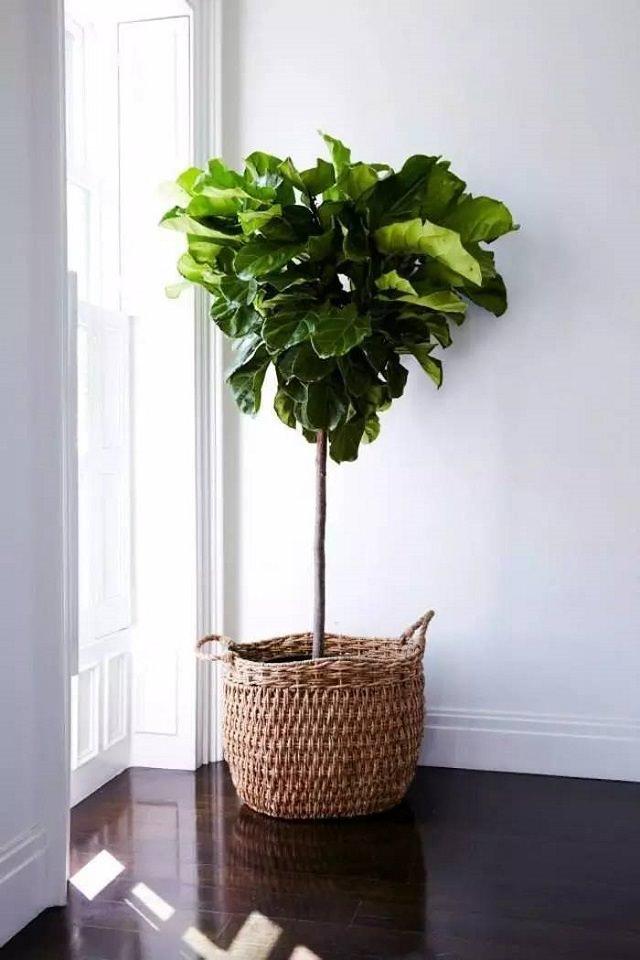
We couldn’t complete this list without adding fiddle leaf fig. Fiddle leaf is a tall, appealing houseplant with glossy, leathery foliage. This large houseplant can change the look of any room.
7. Aluminium Plant
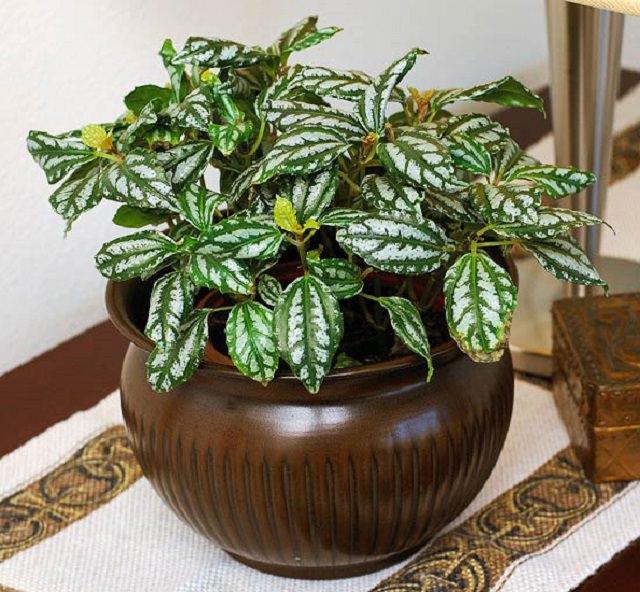
This plant is known for the beautiful silver strips that look like a color of aluminum; these strips appear over the glossy green color of each leaf. One of the beautiful indoor plants it is low maintenance. Keep it in a cool shady spot that receives a few hours of bright indirect light, water only when soil is dry.
8. Red Aglaonema
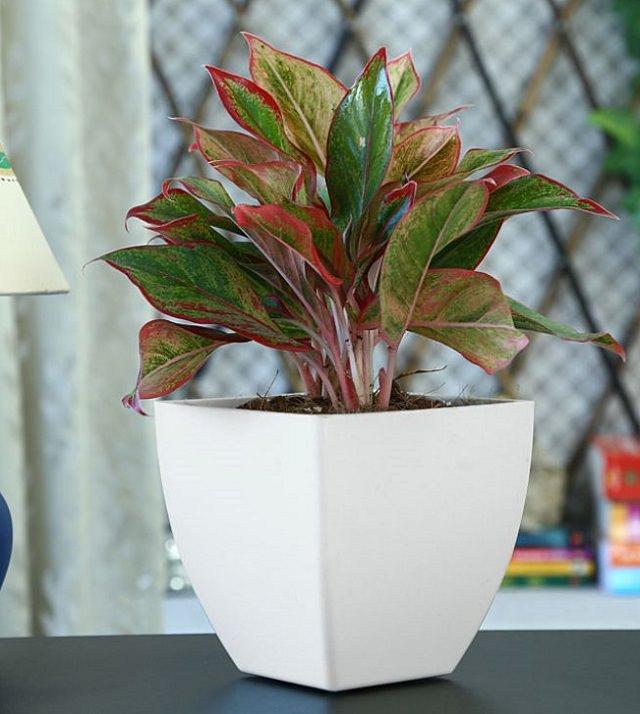
This beautiful houseplant’s dark green leaves with streaks of red and pink make it look really adorable indoors. It is absolutely easy to grow like Chinese evergreen and tolerates low light conditions and drought.
9. Anthurium
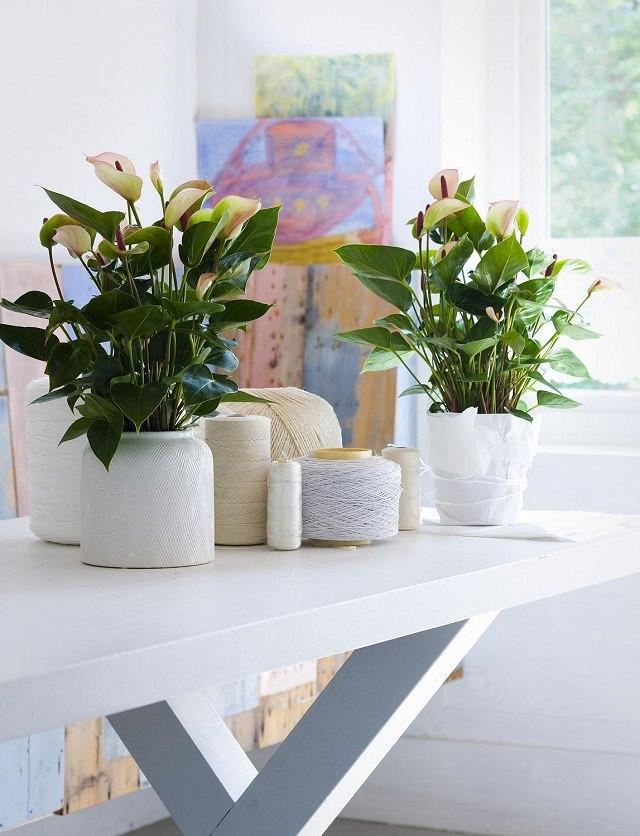
Anthuriums are beautiful houseplants that bloom in alluring shades of white, pink red or lavender. With a rich color palette, long lifespan and low care requirements, they are good for those with a busy lifestyle. Anthurium produces more foliage when grown in low-light conditions, so it’s you keep this plant in a spot that receives indirect sunlight all day.
10. African Mask Plant
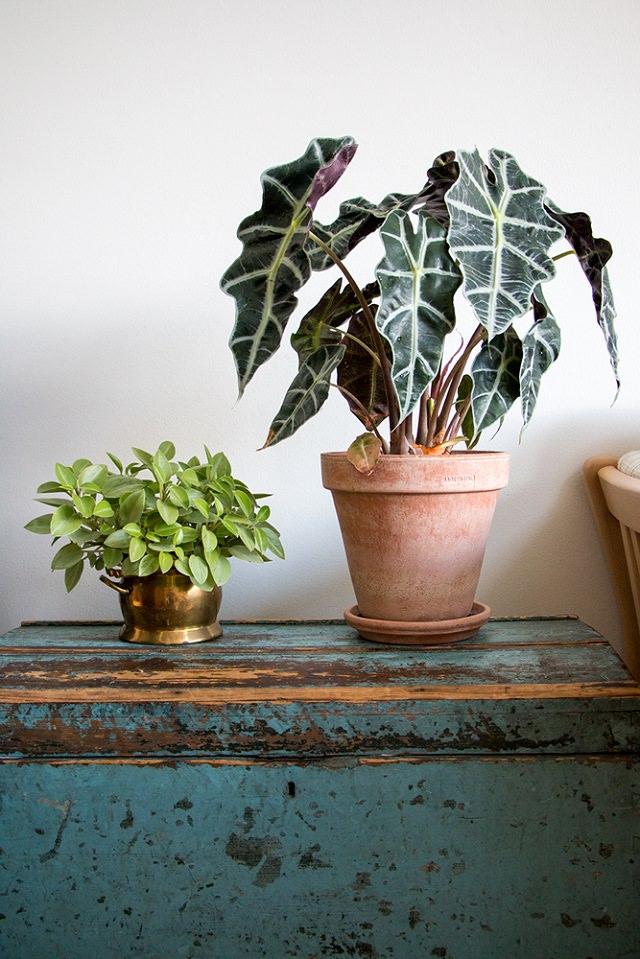
African Mask Plant with its dark green leaves and silvery-white veins can be easily mistaken for an artificial plant. This plant needs moderate watering and a bright position away from direct sunlight. Clean the leaves every few days to keep the plant looking attractive and healthy.
11. Prayer Plant
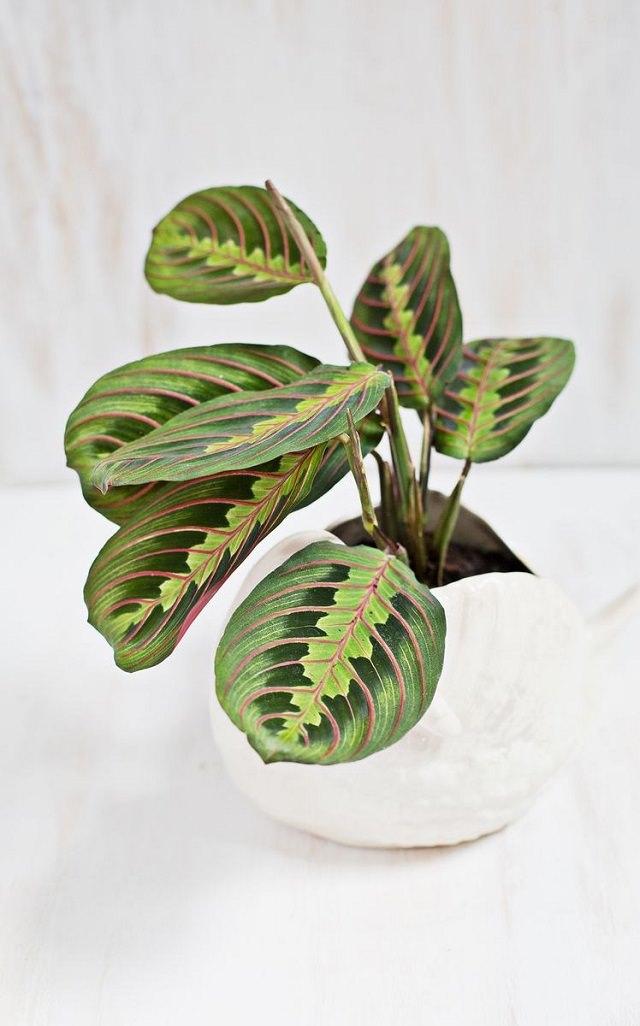
With its beautifully patterned oblong foliage and low care requirements, this exotic houseplant is a lovely addition to any home. It requires bright light, moderate watering, and warm room temperature when it’s grown indoors. One interesting fact about this houseplant is that it folds up its leaves in the night or in the dark place.
12. Bird’s Nest Fern
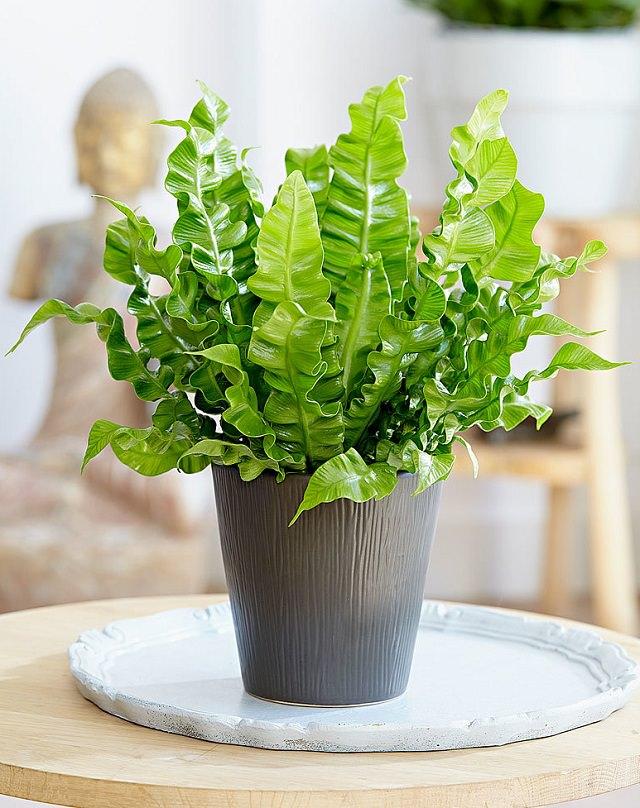
Native to Southeast Asia, bird’s nest fern (Asplenium nidus) is easy to grow if the proper conditions are given—mainly warmth and humidity. Bright indirect light and temperature around 70 F are optimum for growing bird’s nest fern indoors. Visit HGTV to learn more growing this!
13. Adenium
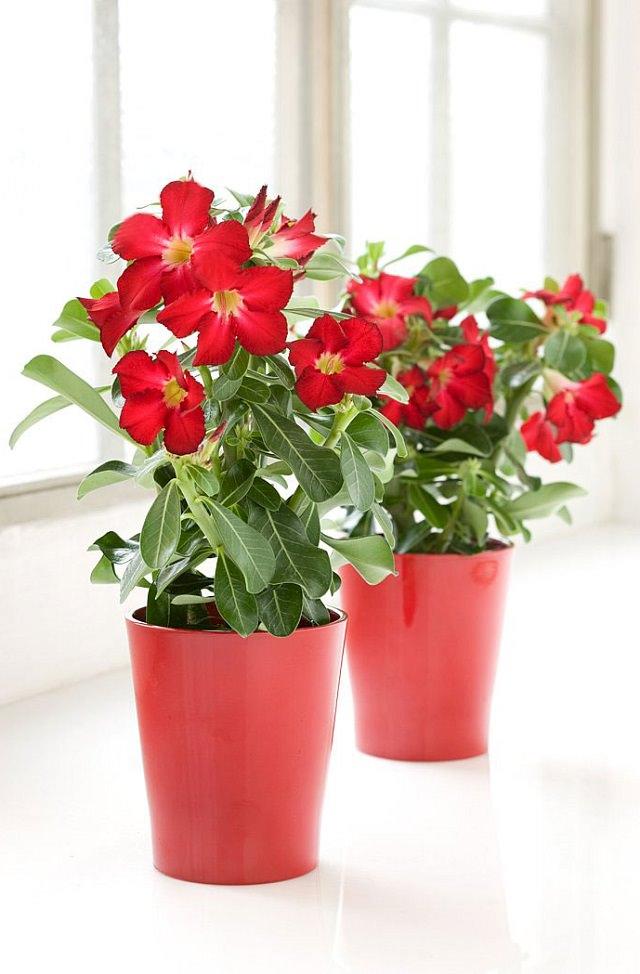
If you live in a warm climate and have a South or West facing window in your room, this is the plant you need to grow. Except for its sunlight requirements, Adenium is a low maintenance houseplant and flowers heartily throughout the year in frost-free climates.
14. Fiber-Optic Grass
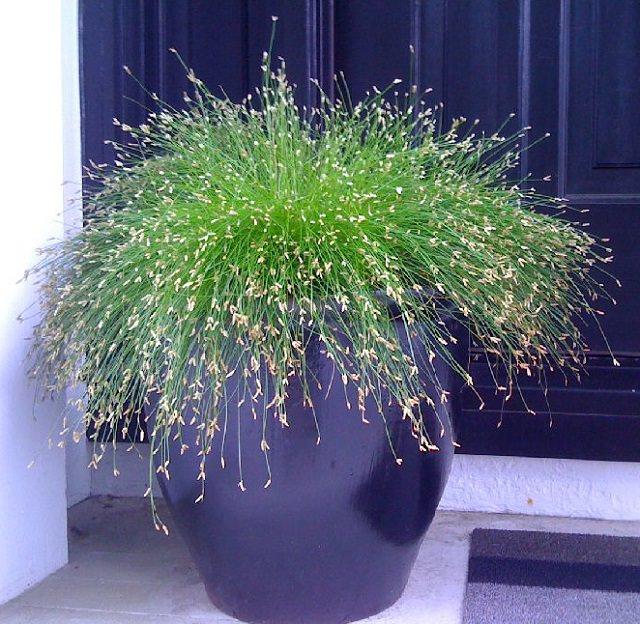
Fiber optic grass is a tropical grass that grows best in subtropical and tropical outdoor areas under USDA Zones (9-11), but it can be grown indoors in cooler regions too (We also added it to our list of BEST ORNAMENTAL GRASSES). Choose an ALLURING pot that will accentuate the beauty of this exotic grass, place it in a warm spot that receives bright light, and keep the soil slightly moist.
15. Ti Plant
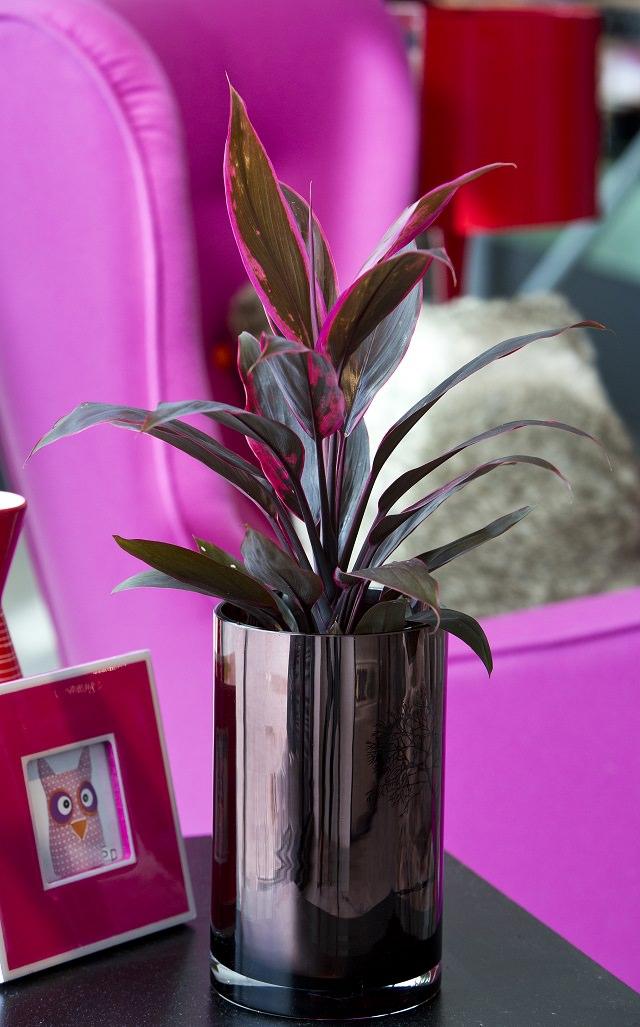
Purple foliage with streaks of blazing pink, the Ti plant looks hot and gorgeous. You can grow this plant for year around foliage attraction. This plant is drought tolerant but has a high light requirement, indoors, it must be kept somewhere where it can absorb direct and indirect light both.
16. Oxalis
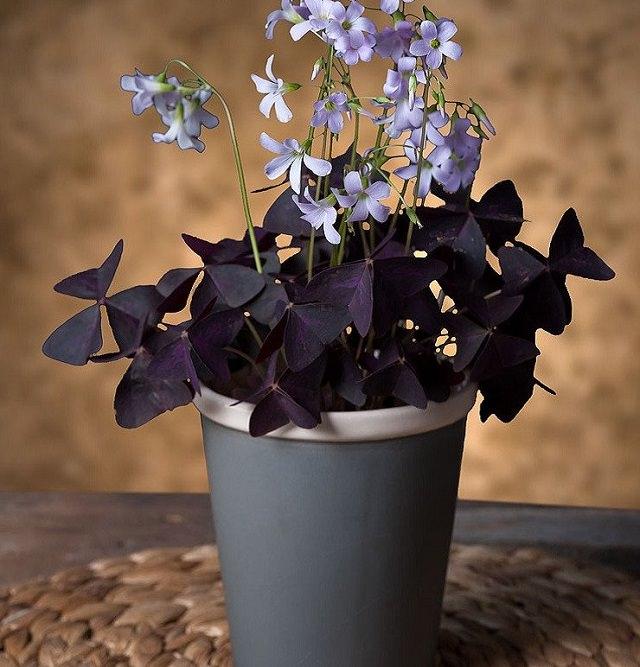
Oxalis belongs to a genus of edible, perennial plants characterized by striking mauve leaves and pink or white blooms. It prefers medium-to-bright light and performs better when grown in evenly moist soil.
17. Ponytail Palm
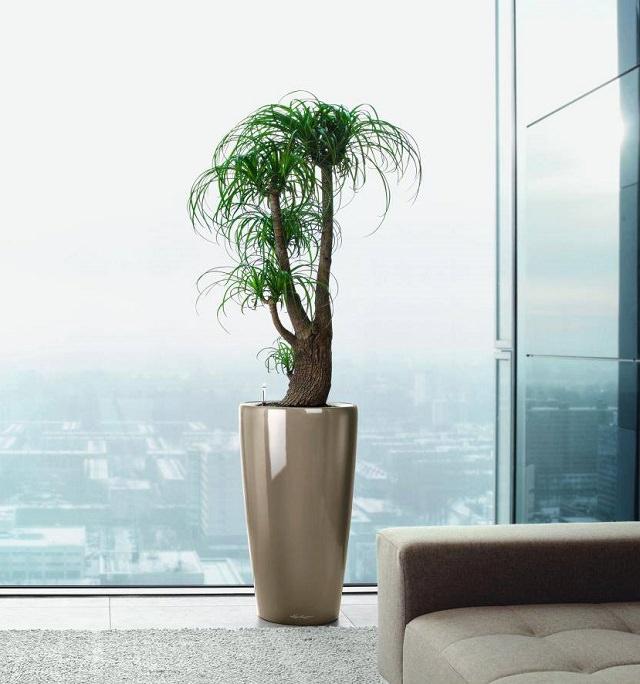
Ponytail Palm is an exotic succulent plant. It looks so interesting, one of the low maintenance plants as it has low watering needs and grows slowly, which means you don’t need to repot it frequently.
18. Poinsettia
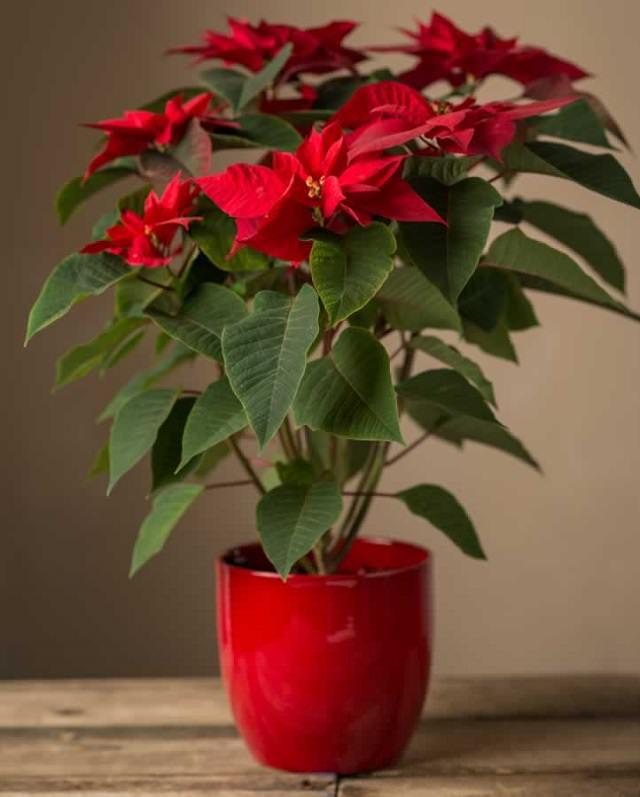
Poinsettias and holiday decorations go hand in hand. This plant looks stunning with or without blooms due to its colorful bracts and foliage. To remain healthy, cheery, and colorful, it needs a bright spot, a couple of hours of morning sunlight and indirect light all day long is sufficient. A draft-free place is best, watering when the soil is dry is required.
19. Rex Begonia
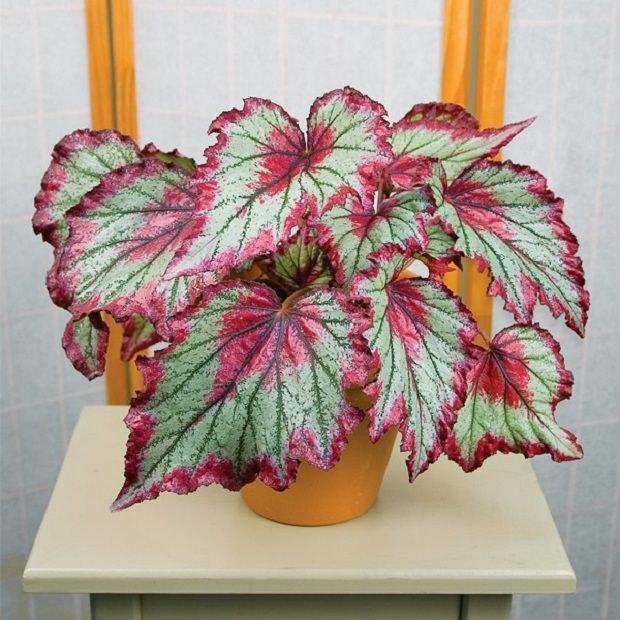
Rex begonias are best-looking begonias out there. Too showy, if you want to add a sparkle to your interior, grow them. Keeping in a bright shady spot in a well-drained medium, it’s important that you don’t overwater them.
20. Monstera Deliciosa
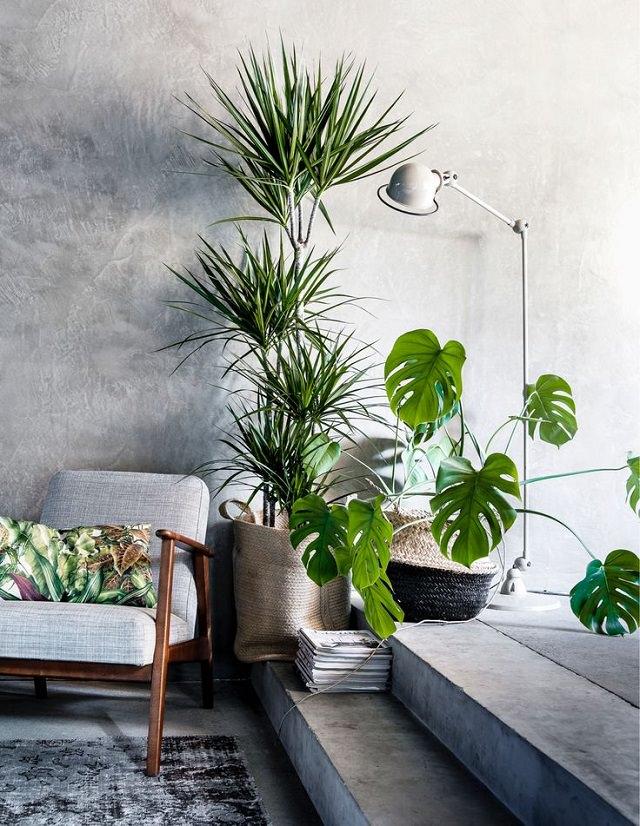
Monstera plant in a good looking pot standing beside a brightly painted wall in its supreme health displaying lush, oversized foliage of dark green color. You can imagine, it’ll look magnificent. Known as split leaf philodendron, you can also keep it in low light, for best result place it near a window where it’ll receive indirect sunlight all day long.
21. Schefflera (Umbrella Tree)
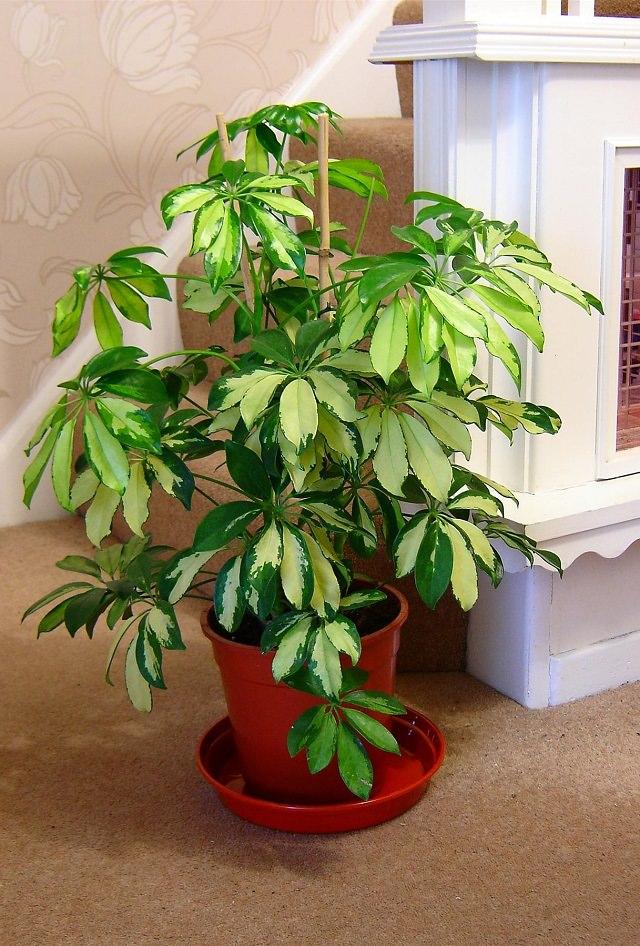
If you’re searching for a tall houseplant to improve the look of your interior, Schefflera is a good choice. Schefflera is finicky about its light requirements and doesn’t like direct sun but this doesn’t mean you can keep it in dim light, a spot near a window that receive indirect sunlight most of the time and have proper air circulation is what it demands. Watering should be done moderately.
22. Streptocarpus
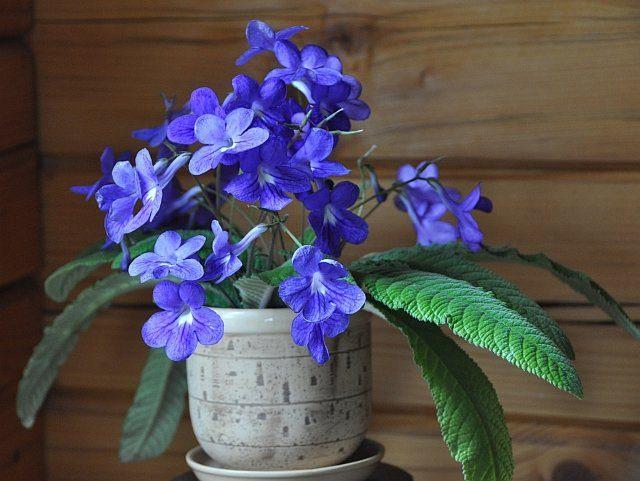
Streptocarpus, better known as the cape primrose is related to the African Violets; it prefers the same growing conditions of indirect light or filtered sunlight and moderately watered soil. Its velvety, deep green leaves and eye-catchy floral clusters hovering above the underlying foliage create a stunning appeal, which makes it perfect for adorning a secluded corner of a drawing room or adding a dash of color to an otherwise, dull space.
23. String of Pearls

The string of pearls is an easy-care succulent plant. It looks stunning in hanging baskets, trailing down. It is drought tolerant so you don’t need to water frequently, once in every other week would be enough.
24. Pleomele (Song of India)
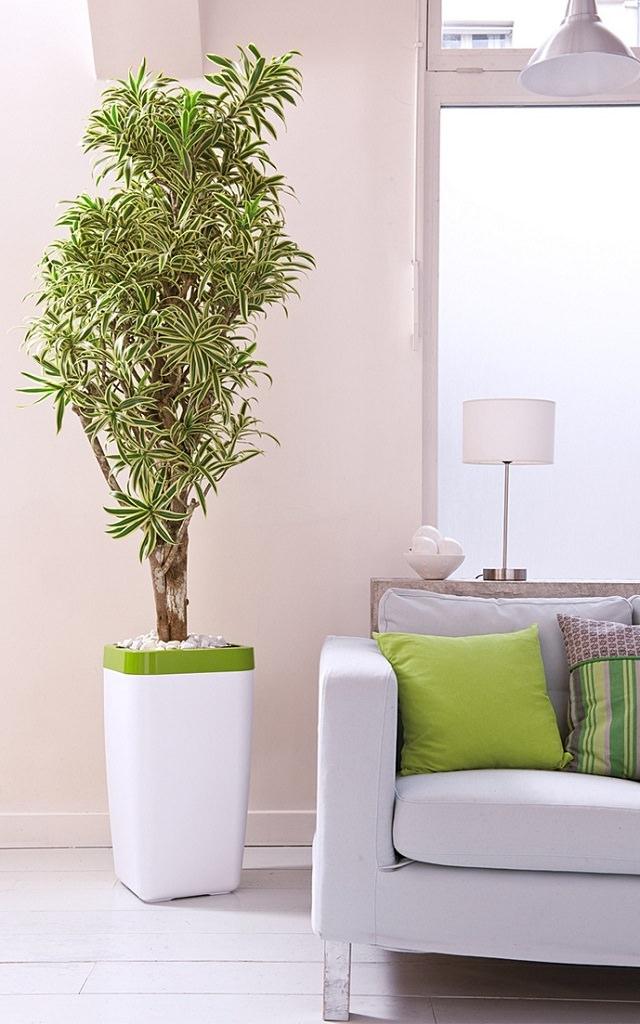
Dracaena reflexa like other plants of this genus is an easy-care houseplant. It’s one of the most ornamental dracaenas; the leaves have solid green color in the middle and a line of lime-yellow color on sides. Good for tabletops and plant stands as pleomele is a slow growing plant.
25. Brazilian Fireworks
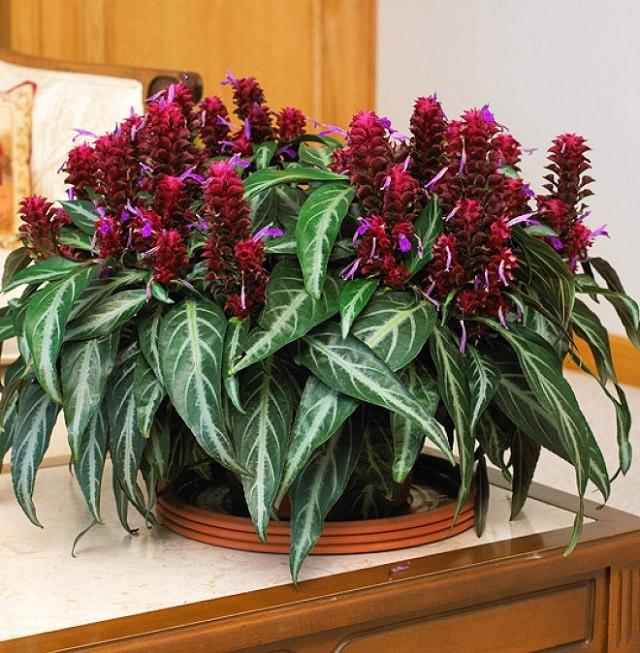
Whether you use this gorgeous tropical plant indoors, or in warm, shade gardens (if living in USDA zones 9-11), the Brazilian fireworks is a year-round delight with or without its flowers. This shade-loving plant is DEMANDING but thrives best when subjected to bright, indirect sunlight and occasional watering.
26. Peace lily
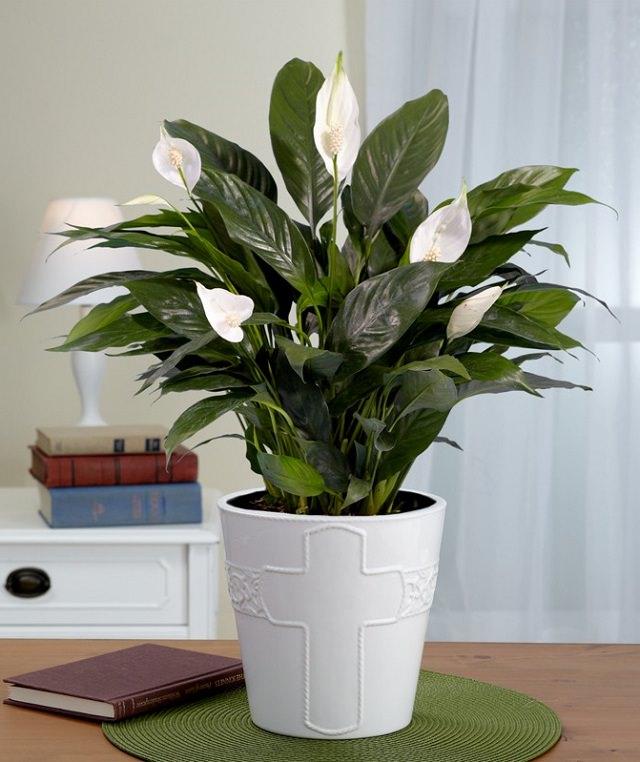
The peace lily is an attractive, low maintenance, air cleaning houseplant. This plant bears showy, spoon-shaped white spathe amidst a spike of white flower. Peace Lily survives best in a shady environment and easily tackle the absence of light.
27. Crown of Thorns
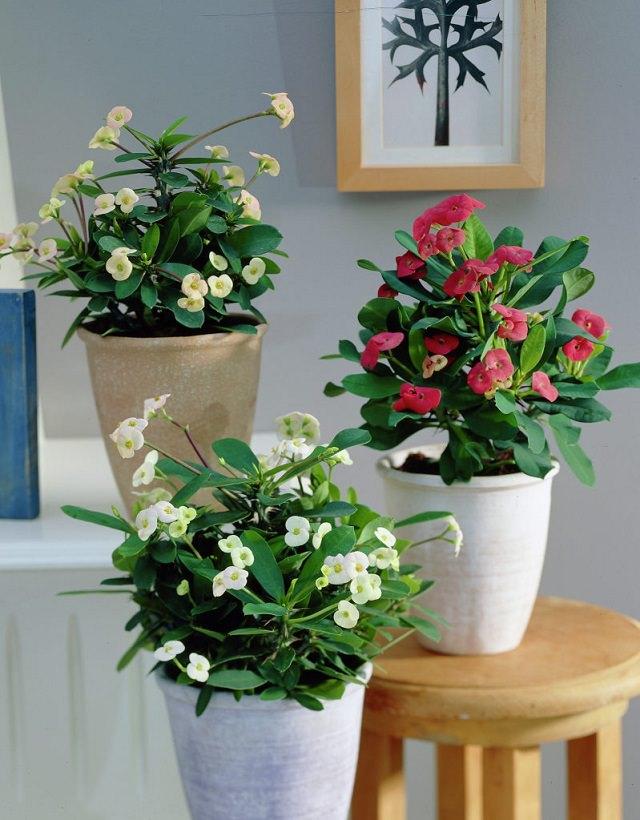
This lovely poinsettia relative is quite tolerant of neglect and thrives well as long as you place it in a bright spot and keep it in drier side. Appreciated for its showy flowers and thick, grayish-green leaves, it is a popular choice for indoor gardening.
28. Money Tree (Pachira Aquatica)

Tall, fat trunk, glossy-large foliage, the money tree is indeed a substitute for the fiddle leaf fig. Only a few indoor trees can become that tall. Also, it’s a low-maintenance houseplant. If you want to learn how to grow Pachira Aquatica indoors, click here!
29. African Violet

African violets are among the most easy-to-care flowering houseplants. They produce delicate, mauve flowers with little effort from your side. You can choose from several varieties, right from the white-edged blooms to the variegated foliage forms.

This demanding houseplant looks gorgeous due to its striking leaves. Picky about watering and dry indoor air and cold drafts. You must need to keep balance in watering.
2. Croton

The bold and bodacious houseplant that is low maintenance too. The mix of yellow, amber, and orange color linear markings on thick dark green foliage, croton looks stunning. To grow, keep it in a spot that receives bright indirect light most of the time and water sporadically.
3. Calathea

Lovely plant, great to look at! Many varieties are available in astonishing color combinations and patterns. This tropical houseplant doesn’t mind low light conditions. Keep it in warm, normal room temperature, saving from cold drafts. It likes humid surroundings and moderate watering.
4. Pencil Cactus

This unusual looking astonishing plant is notorious for its toxic milky sap (take care when handling this plant); still, it’s getting popular as a houseplant. Pencil cactus has medium to high light requirements and low watering needs; it also doesn’t mind dry air. Watering 2-3 times in a month is sufficient. To grow, keep the plant in a spot with ample light, a shaft of sunlight for a few hours or even more and it would do fine.
5. Silver Vase Plant

Unusual but a beautiful indoor plant, the silver vase or “urn plant” belongs to bromeliad family. Overall, growing this houseplant is similar to others– Be careful with watering, provide bright indirect light.
6. Fiddle Leaf Fig

We couldn’t complete this list without adding fiddle leaf fig. Fiddle leaf is a tall, appealing houseplant with glossy, leathery foliage. This large houseplant can change the look of any room.
7. Aluminium Plant

This plant is known for the beautiful silver strips that look like a color of aluminum; these strips appear over the glossy green color of each leaf. One of the beautiful indoor plants it is low maintenance. Keep it in a cool shady spot that receives a few hours of bright indirect light, water only when soil is dry.
8. Red Aglaonema

This beautiful houseplant’s dark green leaves with streaks of red and pink make it look really adorable indoors. It is absolutely easy to grow like Chinese evergreen and tolerates low light conditions and drought.
9. Anthurium

Anthuriums are beautiful houseplants that bloom in alluring shades of white, pink red or lavender. With a rich color palette, long lifespan and low care requirements, they are good for those with a busy lifestyle. Anthurium produces more foliage when grown in low-light conditions, so it’s you keep this plant in a spot that receives indirect sunlight all day.
10. African Mask Plant

African Mask Plant with its dark green leaves and silvery-white veins can be easily mistaken for an artificial plant. This plant needs moderate watering and a bright position away from direct sunlight. Clean the leaves every few days to keep the plant looking attractive and healthy.
11. Prayer Plant

With its beautifully patterned oblong foliage and low care requirements, this exotic houseplant is a lovely addition to any home. It requires bright light, moderate watering, and warm room temperature when it’s grown indoors. One interesting fact about this houseplant is that it folds up its leaves in the night or in the dark place.
12. Bird’s Nest Fern

Native to Southeast Asia, bird’s nest fern (Asplenium nidus) is easy to grow if the proper conditions are given—mainly warmth and humidity. Bright indirect light and temperature around 70 F are optimum for growing bird’s nest fern indoors. Visit HGTV to learn more growing this!
13. Adenium

If you live in a warm climate and have a South or West facing window in your room, this is the plant you need to grow. Except for its sunlight requirements, Adenium is a low maintenance houseplant and flowers heartily throughout the year in frost-free climates.
14. Fiber-Optic Grass

Fiber optic grass is a tropical grass that grows best in subtropical and tropical outdoor areas under USDA Zones (9-11), but it can be grown indoors in cooler regions too (We also added it to our list of BEST ORNAMENTAL GRASSES). Choose an ALLURING pot that will accentuate the beauty of this exotic grass, place it in a warm spot that receives bright light, and keep the soil slightly moist.
15. Ti Plant

Purple foliage with streaks of blazing pink, the Ti plant looks hot and gorgeous. You can grow this plant for year around foliage attraction. This plant is drought tolerant but has a high light requirement, indoors, it must be kept somewhere where it can absorb direct and indirect light both.
16. Oxalis

Oxalis belongs to a genus of edible, perennial plants characterized by striking mauve leaves and pink or white blooms. It prefers medium-to-bright light and performs better when grown in evenly moist soil.
17. Ponytail Palm

Ponytail Palm is an exotic succulent plant. It looks so interesting, one of the low maintenance plants as it has low watering needs and grows slowly, which means you don’t need to repot it frequently.
18. Poinsettia

Poinsettias and holiday decorations go hand in hand. This plant looks stunning with or without blooms due to its colorful bracts and foliage. To remain healthy, cheery, and colorful, it needs a bright spot, a couple of hours of morning sunlight and indirect light all day long is sufficient. A draft-free place is best, watering when the soil is dry is required.
19. Rex Begonia

Rex begonias are best-looking begonias out there. Too showy, if you want to add a sparkle to your interior, grow them. Keeping in a bright shady spot in a well-drained medium, it’s important that you don’t overwater them.
20. Monstera Deliciosa

Monstera plant in a good looking pot standing beside a brightly painted wall in its supreme health displaying lush, oversized foliage of dark green color. You can imagine, it’ll look magnificent. Known as split leaf philodendron, you can also keep it in low light, for best result place it near a window where it’ll receive indirect sunlight all day long.
21. Schefflera (Umbrella Tree)

If you’re searching for a tall houseplant to improve the look of your interior, Schefflera is a good choice. Schefflera is finicky about its light requirements and doesn’t like direct sun but this doesn’t mean you can keep it in dim light, a spot near a window that receive indirect sunlight most of the time and have proper air circulation is what it demands. Watering should be done moderately.
22. Streptocarpus

Streptocarpus, better known as the cape primrose is related to the African Violets; it prefers the same growing conditions of indirect light or filtered sunlight and moderately watered soil. Its velvety, deep green leaves and eye-catchy floral clusters hovering above the underlying foliage create a stunning appeal, which makes it perfect for adorning a secluded corner of a drawing room or adding a dash of color to an otherwise, dull space.
23. String of Pearls

The string of pearls is an easy-care succulent plant. It looks stunning in hanging baskets, trailing down. It is drought tolerant so you don’t need to water frequently, once in every other week would be enough.
24. Pleomele (Song of India)

Dracaena reflexa like other plants of this genus is an easy-care houseplant. It’s one of the most ornamental dracaenas; the leaves have solid green color in the middle and a line of lime-yellow color on sides. Good for tabletops and plant stands as pleomele is a slow growing plant.
25. Brazilian Fireworks

Whether you use this gorgeous tropical plant indoors, or in warm, shade gardens (if living in USDA zones 9-11), the Brazilian fireworks is a year-round delight with or without its flowers. This shade-loving plant is DEMANDING but thrives best when subjected to bright, indirect sunlight and occasional watering.
26. Peace lily

The peace lily is an attractive, low maintenance, air cleaning houseplant. This plant bears showy, spoon-shaped white spathe amidst a spike of white flower. Peace Lily survives best in a shady environment and easily tackle the absence of light.
27. Crown of Thorns

This lovely poinsettia relative is quite tolerant of neglect and thrives well as long as you place it in a bright spot and keep it in drier side. Appreciated for its showy flowers and thick, grayish-green leaves, it is a popular choice for indoor gardening.
28. Money Tree (Pachira Aquatica)

Tall, fat trunk, glossy-large foliage, the money tree is indeed a substitute for the fiddle leaf fig. Only a few indoor trees can become that tall. Also, it’s a low-maintenance houseplant. If you want to learn how to grow Pachira Aquatica indoors, click here!
29. African Violet

African violets are among the most easy-to-care flowering houseplants. They produce delicate, mauve flowers with little effort from your side. You can choose from several varieties, right from the white-edged blooms to the variegated foliage forms.
2
0
文章
苍山洱海
2017年05月23日

Growing plants indoors can make your home look lively and lavish and if you too love that– Must see our 19 best DIY indoor garden decoration ideas!
If you too love indoor gardening (like we do!), learn about the arrangement ideas, DIY tricks and how you can maximize your planting space available indoors in this article.
1. Use Wall Mounted Storage to Keep Pots

The space between windows can also be prime real estate for growing, just like this one in the picture above. You can use wall mounted storage to keep the pots to decorate your home with plants.
2. DIY Pegboard Planter

This DIY pegboard planter project is simple, inexpensive, and easy to follow. If you want to see the step by step tutorial, visit brePURPOSED!
3. DIY Ladder Planter/Ladder Shelf

If you have got an old ladder, use it to keep pots in it. It can be made into an astonishing pot holder, perfect for growing indoor plants. A step by step tutorial is available on our site!
4. DIY Succulent Frame or Succulent Wall Planter

A DIY succulent frame or succulent wall planter is a great way to add a whim to your interior without spending a lot of money on materials you can make this. Here is the tutorial to follow.
5. Mason Jar Ideas

Upcycle mason jars can used to grow herbs. Here are some DIY ideas.
Mason jar can become adorable small pots and can be used to grow plants and herbs indoors. There are myriads of ideas available on the web to look for inspiration, you can look at one of our posts for more ideas!
6. Indoor Chair Planter

Not only outdoors, if you’ve got an old chair create an indoor chair planter and grow succulents or indoor plants on it to add a dramatic touch to your rooms. See more chair planter ideas!
7. Indoor Zen or Japanese Garden

An indoor Japanese or Zen garden can be a beautiful addition to your home when combined with a water feature, flowers of cool colors, stones, or succulents, a great way to add “calmness” to your home. You can also make a mini succulent zen garden in a pot, check out the tutorial here.
8. Flowering Houseplants

Decorate your indoor garden with flowering houseplants. They can add a bright touch to your home, growing them is similar to other indoor plants. Check out our article on best flowering houseplants here.
9. Use Plant Stands

Plant stand can not only increase your indoor planting space but also look elegant and decorate your home. The best thing about them is that you can also DIY them easily, here are some ideas.
10. Succulent Bookend
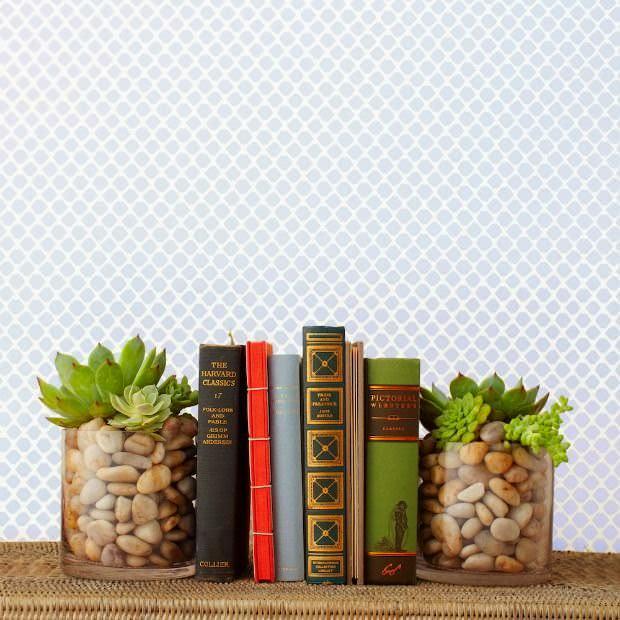
Prop up your favorite reads with this easy-to-make mini garden. Succulents are easy to grow. They add a welcome pop of greenery to any book collection when planted in clear vases filled with pretty river stones. See more of it here.
11. Hanging Coconut Planter
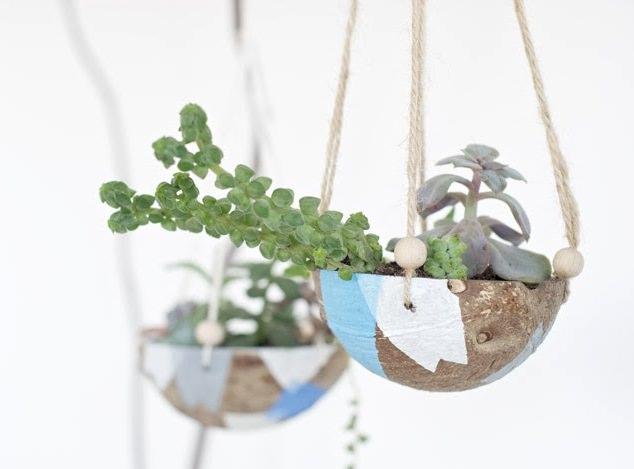
Use coconut shells after eating to create this super cute hanging indoor garden. This project is unique, still simple and doesn’t require much. Check out the tutorial here.
12. Sea Shell Planter
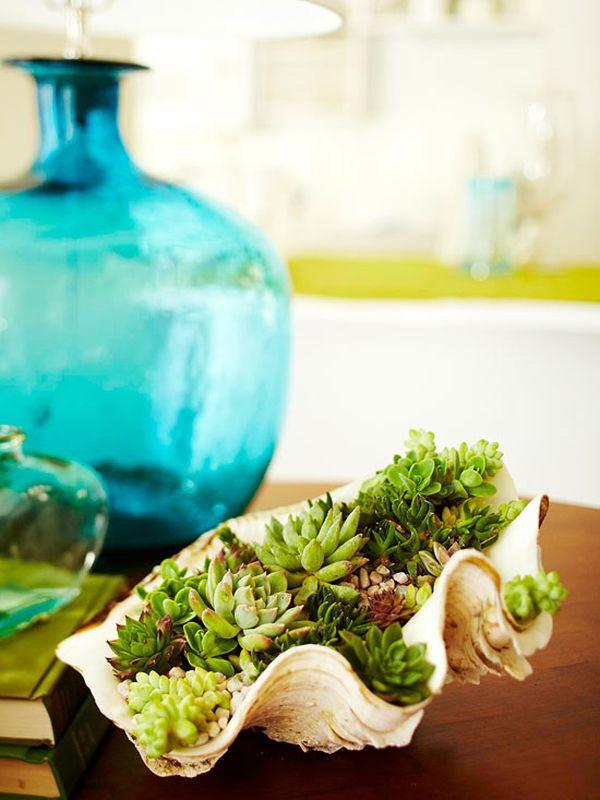
Sea-shell planters are creative ways to show off plants. You can tuck smaller succulents and use them as a centerpiece of your home. Check out these ideas!
13. Use Utility Cart to Hold Pots

Utility cart can be found in stores easily, it has many uses and one of them is this, especially if you’re short of space. Use it to hold planters.
14. Create an Indoor Fairy Garden

This well-planned fairy garden that resembles a gnome village (or many more other fairy garden ideas here) is looking amazing with colorful mushrooms, walkway, tiny houses, and banners.
15. Make a Succulent Dish Garden

Plant succulents in a dish and place it on the table top. It will make the focal point of the room. A complete DIY article on how to make a succulent dish garden is available here.
16. Plant Stand Room Dividers

Ikea plant stand (Socker series)
Plant stands can be used as room dividers, keeping cut beautiful cut flowers, herbs, and small plants. This way you’ll be able to maximize your growing space and create a division in a room too!
17. Keep a Plant Stand Near Window
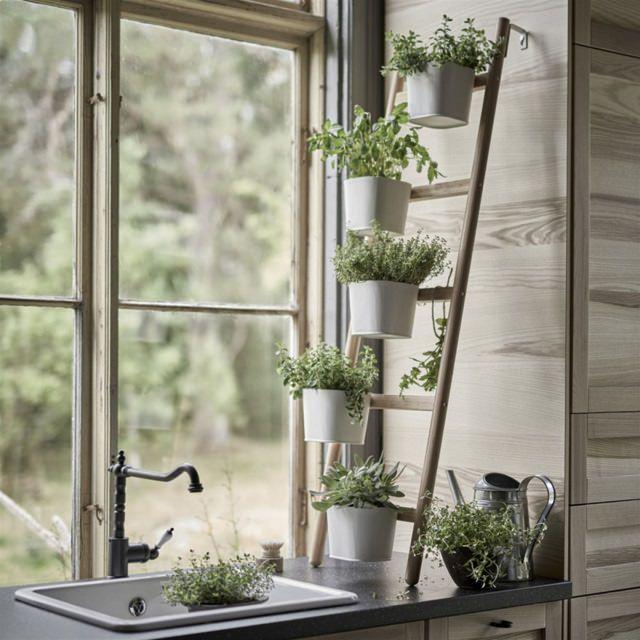
Why just keep plants on a windowsill, let the plants use the sunlight comes from the windows by keeping a plant stand like this.
18. Teacup Herb Garden

Grow a herb garden in vintage teacups that you no longer use. Not only it will look good but this way you will be able to grow your own herbs. If you want to make a teacup planter too, here is the tutorial.
Also Read: Indoor Herb Garden Ideas
19. DIY Mosaic Pots

Take some of your old clay pots and turn them into astonishing mosaic pots. It’s easy! You’ll need a terracotta pot, vase filler chips or alternatively use pot shard or broken tile pieces. You’ll also need glue and spray paint. The first step is to paint the pot in your favorite color and leave it to dry. Once done, lie the pot and glue the chips or shards one by one. See more mosaic ideas!
If you too love indoor gardening (like we do!), learn about the arrangement ideas, DIY tricks and how you can maximize your planting space available indoors in this article.
1. Use Wall Mounted Storage to Keep Pots

The space between windows can also be prime real estate for growing, just like this one in the picture above. You can use wall mounted storage to keep the pots to decorate your home with plants.
2. DIY Pegboard Planter

This DIY pegboard planter project is simple, inexpensive, and easy to follow. If you want to see the step by step tutorial, visit brePURPOSED!
3. DIY Ladder Planter/Ladder Shelf

If you have got an old ladder, use it to keep pots in it. It can be made into an astonishing pot holder, perfect for growing indoor plants. A step by step tutorial is available on our site!
4. DIY Succulent Frame or Succulent Wall Planter

A DIY succulent frame or succulent wall planter is a great way to add a whim to your interior without spending a lot of money on materials you can make this. Here is the tutorial to follow.
5. Mason Jar Ideas

Upcycle mason jars can used to grow herbs. Here are some DIY ideas.
Mason jar can become adorable small pots and can be used to grow plants and herbs indoors. There are myriads of ideas available on the web to look for inspiration, you can look at one of our posts for more ideas!
6. Indoor Chair Planter

Not only outdoors, if you’ve got an old chair create an indoor chair planter and grow succulents or indoor plants on it to add a dramatic touch to your rooms. See more chair planter ideas!
7. Indoor Zen or Japanese Garden

An indoor Japanese or Zen garden can be a beautiful addition to your home when combined with a water feature, flowers of cool colors, stones, or succulents, a great way to add “calmness” to your home. You can also make a mini succulent zen garden in a pot, check out the tutorial here.
8. Flowering Houseplants

Decorate your indoor garden with flowering houseplants. They can add a bright touch to your home, growing them is similar to other indoor plants. Check out our article on best flowering houseplants here.
9. Use Plant Stands

Plant stand can not only increase your indoor planting space but also look elegant and decorate your home. The best thing about them is that you can also DIY them easily, here are some ideas.
10. Succulent Bookend

Prop up your favorite reads with this easy-to-make mini garden. Succulents are easy to grow. They add a welcome pop of greenery to any book collection when planted in clear vases filled with pretty river stones. See more of it here.
11. Hanging Coconut Planter

Use coconut shells after eating to create this super cute hanging indoor garden. This project is unique, still simple and doesn’t require much. Check out the tutorial here.
12. Sea Shell Planter

Sea-shell planters are creative ways to show off plants. You can tuck smaller succulents and use them as a centerpiece of your home. Check out these ideas!
13. Use Utility Cart to Hold Pots

Utility cart can be found in stores easily, it has many uses and one of them is this, especially if you’re short of space. Use it to hold planters.
14. Create an Indoor Fairy Garden

This well-planned fairy garden that resembles a gnome village (or many more other fairy garden ideas here) is looking amazing with colorful mushrooms, walkway, tiny houses, and banners.
15. Make a Succulent Dish Garden

Plant succulents in a dish and place it on the table top. It will make the focal point of the room. A complete DIY article on how to make a succulent dish garden is available here.
16. Plant Stand Room Dividers

Ikea plant stand (Socker series)
Plant stands can be used as room dividers, keeping cut beautiful cut flowers, herbs, and small plants. This way you’ll be able to maximize your growing space and create a division in a room too!
17. Keep a Plant Stand Near Window

Why just keep plants on a windowsill, let the plants use the sunlight comes from the windows by keeping a plant stand like this.
18. Teacup Herb Garden

Grow a herb garden in vintage teacups that you no longer use. Not only it will look good but this way you will be able to grow your own herbs. If you want to make a teacup planter too, here is the tutorial.
Also Read: Indoor Herb Garden Ideas
19. DIY Mosaic Pots

Take some of your old clay pots and turn them into astonishing mosaic pots. It’s easy! You’ll need a terracotta pot, vase filler chips or alternatively use pot shard or broken tile pieces. You’ll also need glue and spray paint. The first step is to paint the pot in your favorite color and leave it to dry. Once done, lie the pot and glue the chips or shards one by one. See more mosaic ideas!
2
3
文章
Colorful
2017年05月23日

You love growing plants indoors, but they die soon (or you kill them)? This won’t happen again if you avoid these 9 mistakes!
Having plants in your house is like a baby to care. There are many things (if you’re new) you do not know when you plan to keep a plant in the house or the garden. If you are wondering WHY YOUR INDOOR PLANTS ARE DYING even after taking so much care and extra pampering, then there are some mistakes that you are doing. Here are the nine little (or the BIGGEST) mistakes which can kill your plant. So avoid doing them!
1. Keeping the plant in a location that is not suitable

Every plant has its specific needs, do’s and don’t do’s. If you don’t know what they are, acquire the knowledge from a florist, books or from the best place, the internet (consider our website)! Some plants are very specific with their placement indoor or outdoor. Placing them in an unsuitable location is certainly kill them sooner or later, quickly or gradually.
Mostly the plants growing indoors die due to this reason. You must read what a plant needs before you seek a place for it. Some plants require shade, indirect light or direct sunlight, while some need moisture. If a plant needs more level of moisture, then keep it in a shaded area. If not done so, all the moisture in the soil will dry up, and this will certainly kill the plant.
2. Changing the location to and fro
Plants adjust to the spot where they kept for a while, either at home or outdoors. When they moved often, it becomes difficult for them to adapt quickly to the different conditions of the new environment. Also, moving the plants frequently can hurt the growth of your houseplant.
3. Wrong soil
We say– Soil is the key! And when it comes to growing plants indoors, you can’t compromise with soil. A soilless potting mix is what we suggest. You can also make your own or choose high quality, organic soil mix.
Make sure that the soil you mix or buy is according to your plant’s needs. Some plants do better in moisture retaining, dense soil, while other plants, such as cacti, need light, fast-draining soil with high sand and peat content, to prevent root rot.
4. Overwatering

Even the experienced gardener make this mistake, this is the problem with container gardening. People who are new to gardening or growing plants do this– they think that giving more water to the plant will keep it healthy and let it grow faster. However, especially indoors, where the sun is scarce, the situation is different. Keeping plants on a little bit drier side is a good idea but if the plant you’re growing is a moisture loving plant then keep the soil slightly moist.
It is recommended that you do the research about the watering needs of your plant. Also, the most important factor that decides the watering requirements of a plant is the climate in which you’re growing it. Usually indoors, watering the plants only once a week should be enough though some of the low maintenance plants require even less water. It’s a good idea to feel the soil in every three days and when you water, water the plants thoroughly.
5. Keeping plants in too much or too little light
It is true that plants need light, but indoor plants are tender, low sunlight plants and exceeding their light requirement can kill them. It is always better to know about your plant before placing it anywhere. Some plants require little light for healthy growth. If they are supplied with more light, then this can kill or debilitate them.
6. Exposing to extreme temperatures
Indoor plants are indoor plants because they like indoor conditions and unvarying temperature, there are only a few that like high or low temperature than normal average room temperature. The safest daytime temperature for indoor plants is 65-75 F (18-24 C) or somewhere around it, whereas, during night time, fall in 5-10 F in temperature is optimum. Moderate temperature works well for houseplants and having a constant temperature leads to healthy growth.
7. Keeping the plant rootbound

If you have a houseplant for a long time and you do not re-pot it then it, becomes bound to the pot you have planted it in. In optimum conditions, (if the plant is not slow-growing) plants outgrow the pot within a year or two. When leaves start to turn yellow or if you see the roots popping out, it is the signal to re-pot the plant. This indication is due to less space and freshness to grow healthy. When sending Plants for housewarming, you tend to gift it is small pot, but later it can be repotted in larger spaces.
Leaves turning yellow are the indication of insufficient space, water, nutrients and air. So when you see these signs, take the right step and re-pot the plant in a larger space.8. Neglecting the plants
Many of us, plant the plants and forget about them. Underwatering is one of the consequences of it. Neglecting plants is the reason why most people kill the indoor plants. Not looking at plants suffering from pests or diseases, missing to prune, no regular fertilization. All this must be avoided.
9. Not cleaning the leaves
Is it important to clean the leaves of the houseplants? Well, yes! For two reasons you should clean the leaves of your houseplants. First, it makes them look attractive. Second, it makes them HEALTHY! Already, the sun is scarce indoors, and the layer of dust accumulated on the foliage of houseplants contributes to blocking the direct or indirect sunlight and reduce the plant’s ability to photosynthesize. And a result you get a weak and stressful plant. Gardening Know How has an important article on this. Check out!
Having plants in your house is like a baby to care. There are many things (if you’re new) you do not know when you plan to keep a plant in the house or the garden. If you are wondering WHY YOUR INDOOR PLANTS ARE DYING even after taking so much care and extra pampering, then there are some mistakes that you are doing. Here are the nine little (or the BIGGEST) mistakes which can kill your plant. So avoid doing them!
1. Keeping the plant in a location that is not suitable

Every plant has its specific needs, do’s and don’t do’s. If you don’t know what they are, acquire the knowledge from a florist, books or from the best place, the internet (consider our website)! Some plants are very specific with their placement indoor or outdoor. Placing them in an unsuitable location is certainly kill them sooner or later, quickly or gradually.
Mostly the plants growing indoors die due to this reason. You must read what a plant needs before you seek a place for it. Some plants require shade, indirect light or direct sunlight, while some need moisture. If a plant needs more level of moisture, then keep it in a shaded area. If not done so, all the moisture in the soil will dry up, and this will certainly kill the plant.
2. Changing the location to and fro
Plants adjust to the spot where they kept for a while, either at home or outdoors. When they moved often, it becomes difficult for them to adapt quickly to the different conditions of the new environment. Also, moving the plants frequently can hurt the growth of your houseplant.
3. Wrong soil
We say– Soil is the key! And when it comes to growing plants indoors, you can’t compromise with soil. A soilless potting mix is what we suggest. You can also make your own or choose high quality, organic soil mix.
Make sure that the soil you mix or buy is according to your plant’s needs. Some plants do better in moisture retaining, dense soil, while other plants, such as cacti, need light, fast-draining soil with high sand and peat content, to prevent root rot.
4. Overwatering

Even the experienced gardener make this mistake, this is the problem with container gardening. People who are new to gardening or growing plants do this– they think that giving more water to the plant will keep it healthy and let it grow faster. However, especially indoors, where the sun is scarce, the situation is different. Keeping plants on a little bit drier side is a good idea but if the plant you’re growing is a moisture loving plant then keep the soil slightly moist.
It is recommended that you do the research about the watering needs of your plant. Also, the most important factor that decides the watering requirements of a plant is the climate in which you’re growing it. Usually indoors, watering the plants only once a week should be enough though some of the low maintenance plants require even less water. It’s a good idea to feel the soil in every three days and when you water, water the plants thoroughly.
5. Keeping plants in too much or too little light
It is true that plants need light, but indoor plants are tender, low sunlight plants and exceeding their light requirement can kill them. It is always better to know about your plant before placing it anywhere. Some plants require little light for healthy growth. If they are supplied with more light, then this can kill or debilitate them.
6. Exposing to extreme temperatures
Indoor plants are indoor plants because they like indoor conditions and unvarying temperature, there are only a few that like high or low temperature than normal average room temperature. The safest daytime temperature for indoor plants is 65-75 F (18-24 C) or somewhere around it, whereas, during night time, fall in 5-10 F in temperature is optimum. Moderate temperature works well for houseplants and having a constant temperature leads to healthy growth.
7. Keeping the plant rootbound

If you have a houseplant for a long time and you do not re-pot it then it, becomes bound to the pot you have planted it in. In optimum conditions, (if the plant is not slow-growing) plants outgrow the pot within a year or two. When leaves start to turn yellow or if you see the roots popping out, it is the signal to re-pot the plant. This indication is due to less space and freshness to grow healthy. When sending Plants for housewarming, you tend to gift it is small pot, but later it can be repotted in larger spaces.
Leaves turning yellow are the indication of insufficient space, water, nutrients and air. So when you see these signs, take the right step and re-pot the plant in a larger space.8. Neglecting the plants
Many of us, plant the plants and forget about them. Underwatering is one of the consequences of it. Neglecting plants is the reason why most people kill the indoor plants. Not looking at plants suffering from pests or diseases, missing to prune, no regular fertilization. All this must be avoided.
9. Not cleaning the leaves
Is it important to clean the leaves of the houseplants? Well, yes! For two reasons you should clean the leaves of your houseplants. First, it makes them look attractive. Second, it makes them HEALTHY! Already, the sun is scarce indoors, and the layer of dust accumulated on the foliage of houseplants contributes to blocking the direct or indirect sunlight and reduce the plant’s ability to photosynthesize. And a result you get a weak and stressful plant. Gardening Know How has an important article on this. Check out!
2
2
文章
粉团
2017年05月23日

Do a few of these chores in your garden in the EARLY morning, and you’ll see incredible results in no time!

1. Watering
Plants do better if watered in the early morning. At this time the sun starts to rise and day remains cool, and water is absorbed into the soil pretty well without the evaporation. Plants that are hydrated are better equipped to withstand the midday sun but if they’re watered in the hot midday sun the most of the water lost through evaporation, and this can also scorch the leaves. One more benefit of early morning watering is that the leaves become dried until the night approaches, which means fewer diseases and insects.
2. Pesticide or fertilizer application
Never apply the pesticide or even the foliage fertilizer during the heat of the day, which means late morning or afternoon. The best time to use the pesticides or fertilizer is in the early morning until 7 am or in the dusk. Both the time are perfect because the sun has not risen during this time frame. It’s the same phenomenon like above. The plants absorb the applied liquid fertilizer or pesticide best in an early morning.
3. Weeding
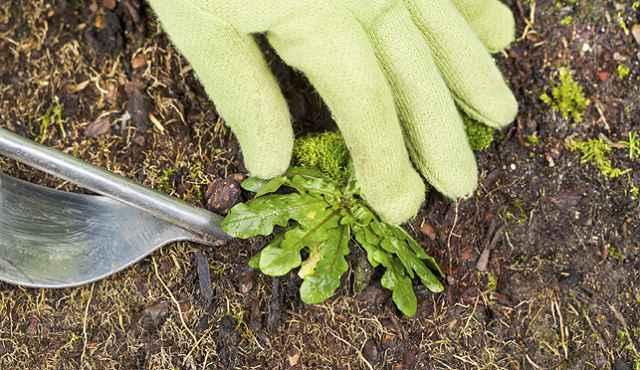
At the morning time when the soil remains moist and cool, weeding your garden becomes easy as the unwanted
plants you don’t desire in your garden pulls out quickly. Also, the morning time can be very relaxing, and during a quick walk in your garden, you can remove the plants invading your space without any difficulty.
4. Cut flowers
Love to have vases full of fresh and colorful cut flowers? Early morning is actually the best time for you to pick cut flowers from your garden. At this time, the stems are full of water, and they haven’t been dehydrated by the sun. If you cut your flowers in the morning, they will have a longer vase life.
5. Harvesting
Whether you need to harvest a little or bountiful, the best harvesting time comes in the early morning. Just after the dew has cleared is a perfect time. This is when the fruits and vegetables have the most water content, they taste better and have more shelf life. Here’s an interesting article to read, which informs you why harvesting in the morning is preferable.
6. Fill bird baths and bird feeders
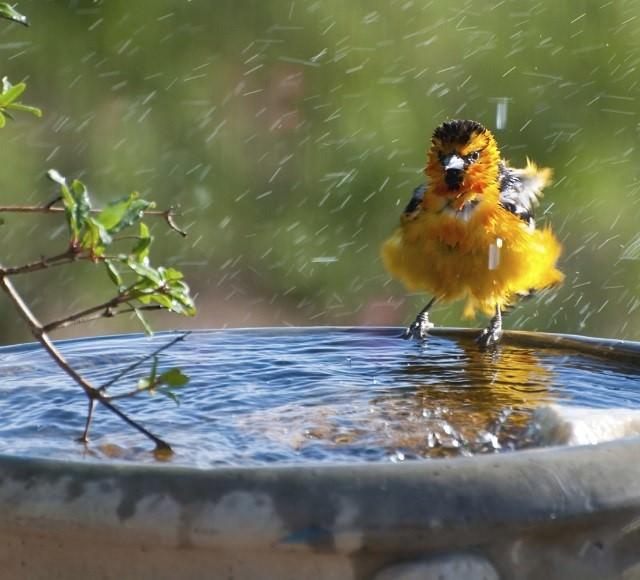
Feeding the birds is one of the most joyous experiences that you can enjoy in your garden. Birds are the original early risers, and they like to eat early. They come first to the place where they always find the food. If you fill up your bird feeders in the early morning, birds will be more encouraged to come to your garden throughout the day. You may get to see some of them frolicking in the bird bath too if you have filled it as well.
7. Planting and transplanting
The best planting or transplanting time is on a cool or cloudy day, either early in the morning or the evening. This gives your transplants a time to set and acclimate well.
8. Take cuttings for propagation
The best time to take cuttings for propagation is early in the morning. According to Ann on garden.org— “The plants’ natural rooting hormones are highest up on the tips of the plants in the morning, so you stand a better chance of propagation by taking your cuttings as early as you can.”

1. Watering
Plants do better if watered in the early morning. At this time the sun starts to rise and day remains cool, and water is absorbed into the soil pretty well without the evaporation. Plants that are hydrated are better equipped to withstand the midday sun but if they’re watered in the hot midday sun the most of the water lost through evaporation, and this can also scorch the leaves. One more benefit of early morning watering is that the leaves become dried until the night approaches, which means fewer diseases and insects.
2. Pesticide or fertilizer application
Never apply the pesticide or even the foliage fertilizer during the heat of the day, which means late morning or afternoon. The best time to use the pesticides or fertilizer is in the early morning until 7 am or in the dusk. Both the time are perfect because the sun has not risen during this time frame. It’s the same phenomenon like above. The plants absorb the applied liquid fertilizer or pesticide best in an early morning.
3. Weeding

At the morning time when the soil remains moist and cool, weeding your garden becomes easy as the unwanted
plants you don’t desire in your garden pulls out quickly. Also, the morning time can be very relaxing, and during a quick walk in your garden, you can remove the plants invading your space without any difficulty.
4. Cut flowers
Love to have vases full of fresh and colorful cut flowers? Early morning is actually the best time for you to pick cut flowers from your garden. At this time, the stems are full of water, and they haven’t been dehydrated by the sun. If you cut your flowers in the morning, they will have a longer vase life.
5. Harvesting
Whether you need to harvest a little or bountiful, the best harvesting time comes in the early morning. Just after the dew has cleared is a perfect time. This is when the fruits and vegetables have the most water content, they taste better and have more shelf life. Here’s an interesting article to read, which informs you why harvesting in the morning is preferable.
6. Fill bird baths and bird feeders

Feeding the birds is one of the most joyous experiences that you can enjoy in your garden. Birds are the original early risers, and they like to eat early. They come first to the place where they always find the food. If you fill up your bird feeders in the early morning, birds will be more encouraged to come to your garden throughout the day. You may get to see some of them frolicking in the bird bath too if you have filled it as well.
7. Planting and transplanting
The best planting or transplanting time is on a cool or cloudy day, either early in the morning or the evening. This gives your transplants a time to set and acclimate well.
8. Take cuttings for propagation
The best time to take cuttings for propagation is early in the morning. According to Ann on garden.org— “The plants’ natural rooting hormones are highest up on the tips of the plants in the morning, so you stand a better chance of propagation by taking your cuttings as early as you can.”
10
13
文章
Hande Salcan
2017年05月23日


There are ways to get free plants for your garden, and I don’t mean bribing the checker at the home improvement store. Nope, these are more satisfying anyway! The way to get free plants is to propagate plants that already exist, either from your own garden, or a neighbor or gardening buddies. To propagate means to basically cause the plant to multiply… thus taking one plant, and turning it into several, or even many! Free plants!
There are many ways to propagate plants, but many of them are too complicated for the average gardener, and usually take extreme patience and a greenhouse. I’m going to concentrate on the ones that are easy and within the ability of even a beginner. These methods include gathering seed, division, softwood cuttings, and leaf cuttings. Our feature photo, above, is a great example of division by cuttings… ‘Cafe Sucre Furine’ shows us how to propagate basil by cuttings. (Keep reading, we cover it!)
I’m not going to get detailed about seed saving, because we just did a post on that, but you should jump over to learn all our seed saving tips.
Division is an easy process that splits one plant into several, best done in spring or fall. Any plant that grows with more than one central “stalk” is technically a candidate for division, but certain plants are easier pickings. In other words, plants that grow in “clumps”. Good choices? Most perennials without a taproot, such as hostas, day lilies, iris, grasses, phlox, coneflower, black eyed susans, asters and astilbe. (And many, many more!) The basic steps?
Dig up the plant with a sharp spade
Separate the crowns to make new plants. You can tease the roots apart with your fingers with some plants, but others you may have to cut them with a knife. Don’t worry, they will be fine!
Replant each crown you separated as a new plant immediately, and water well until they get established.
Check out this video on dividing perennials from ‘Fine Gardening’.
Softwood cuttings are kind of like when we cut a stem of a houseplant and stick it in a glass of water until it grows roots, except we stick it into moist potting soil and trap it with a plastic bag. (OK, you can just stick some plants into water, let’s be honest… some are just so easy!) Photo credit below – Education Outside at AFY.
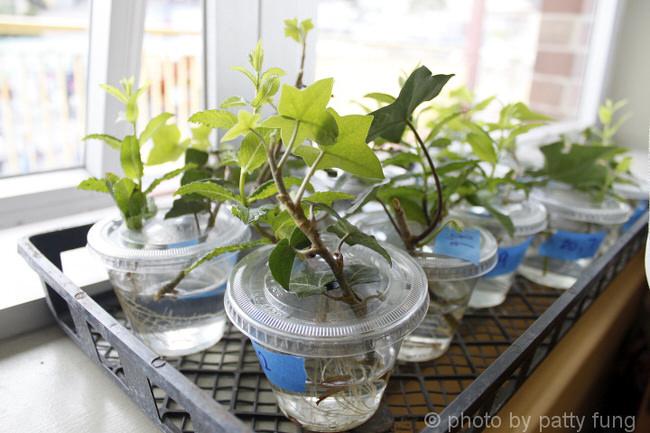
If you want to try softwood cuttings on plants with tougher stems, like hydrangeas, follow this tutorial by ‘This Old House‘… this should work for many soft stemmed shrubs. This is just a touch more work, but don’t let it scare you. And when they mention rooting hormone powder and you start to panic, don’t worry. Just ask for it at your local nursery, it looks like cornstarch and just helps… you can do it without though. Don’t believe me? Here is a softwood cutting tutorial for softer stemmed perennials and herbs from ‘Mother Earth Living’… and they agree with me, it doesn’t have to be that complicated!

The last easy method is propagation by leaf cuttings. What this means is you basically cut off a leaf and some of the stem, then plant it into soil medium just like you did for softwood cuttings. This works really well with succulents, which are so popular right now. In fact in my garden, these propagate themselves. When a windstorm breaks off some stem or leaves, they replant themselves everywhere! So really, how hard can it be? (My sedum “Angelina” is a main offender, but I love it!) Wikihow has a great tutorial on how to propagate succulents by leaf cutting.
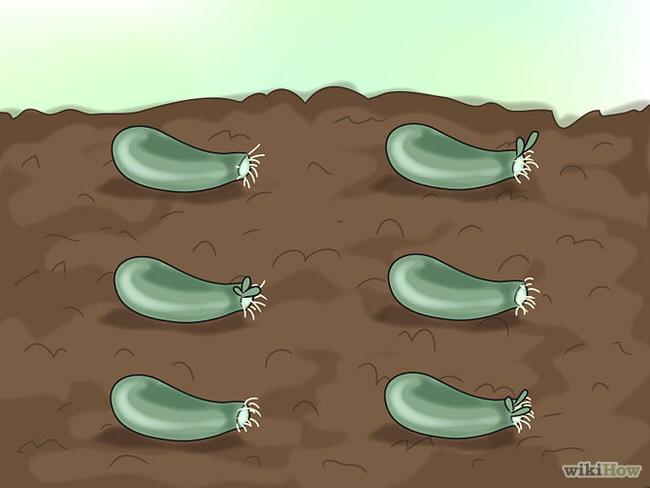
Ok, so that’s it! Easy ways to make free plants for your garden, or host a swap party with family and friends and share!
8
9
文章
Colorful
2017年05月23日

New to growing plants and no idea what you should grow indoors? Learn about these 15 Best Houseplants for Beginners. They all are easy to grow!
Potted houseplants provide a lavish look and can be used to decorate the interior at low cost. Also, they create positive impact and many of them purify the air. But what you’ll do if you don’t have much knowledge about growing plants and the houseplants that are best to grow? Simple! Learn about these 15 Best Houseplants for Beginners! They are easy to grow and tolerate poor conditions.
1. Snake Plant
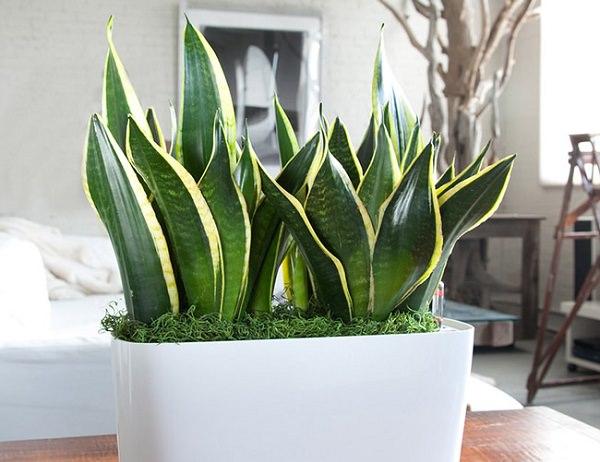
Snake plant is one of the best plants for the beginners. Easy to grow and hard to kill, it can be grown in low light and need to be watered occasionally. Snake plant also removes toxins from the air– All this makes it a perfect houseplant for beginners.
2. Heartleaf Philodendron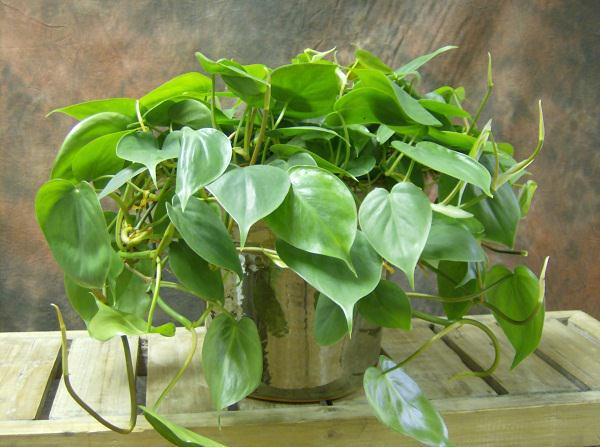
Philodendron scandens is extremely easy to grow and great for beginners. It needs a moderate amount of light and prefers the soil to dry out between watering spells.
3. Spider Plant
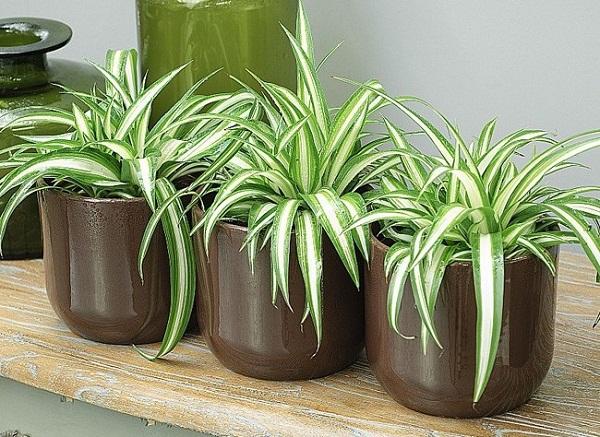
One of the most popular houseplants. Its popularity is due to its toughness and the ease of growing and maintenance. The plant can easily adapt to almost any condition. Keep the plant in a bright spot and maintain slight moisture in the soil and it will grow happily.
4. Peace Lily

The peace lily is among the easiest plants to grow indoors. It can tolerate a wide range of lighting conditions, and needs only moderate watering. With graceful curving leaves and white flower that rise up from the dark foliage, peace lily looks exotic and elegant.
5. English Ivy
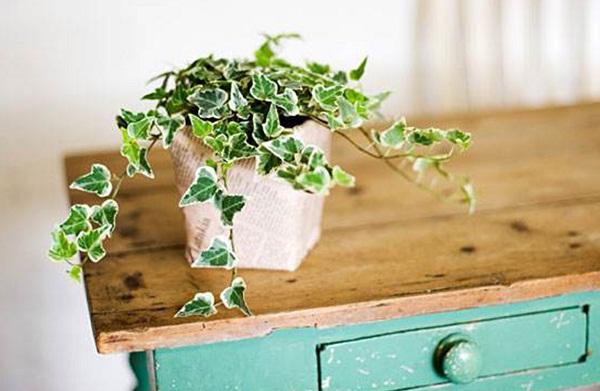
English Ivy is very hardy and easy to grow. Keep the pot in a spot that receives bright indirect sun and plant it in a container that is wide and shallow rather than narrow and deep.
6. Succulents and Cactus

Succulents and cacti are ideal for those who forget to water and care for plants. They are very adaptable and can survive many adverse conditions.
They need to be placed on a bright spot and a well-drained soil with little water.
7. Lucky Bamboo
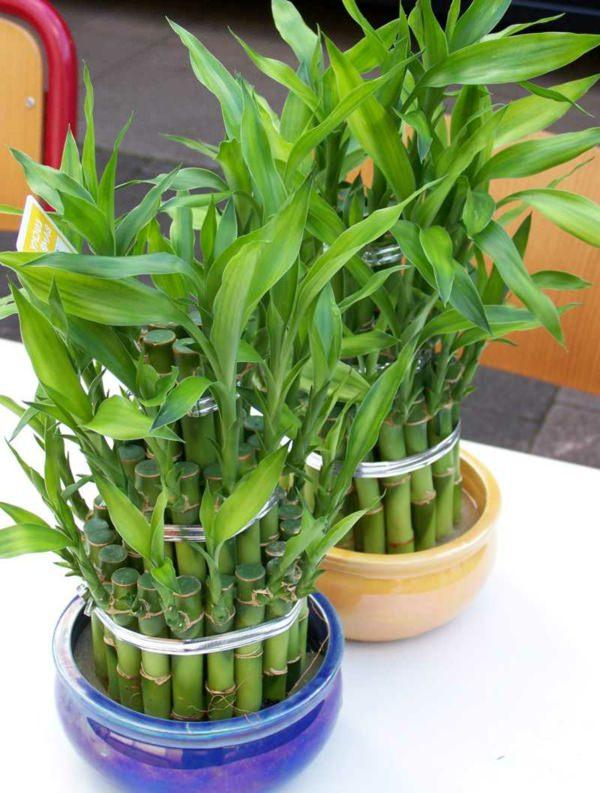
Lucky bamboo is not a bamboo, but a plant belongs to Dracaena genus. It is an easy-care houseplant. Just provide it abundant water and it’ll grow well even in indirect light. Protect the plant from cold drafts and provide iron fertilizer occasionally.
8. Jade Plant
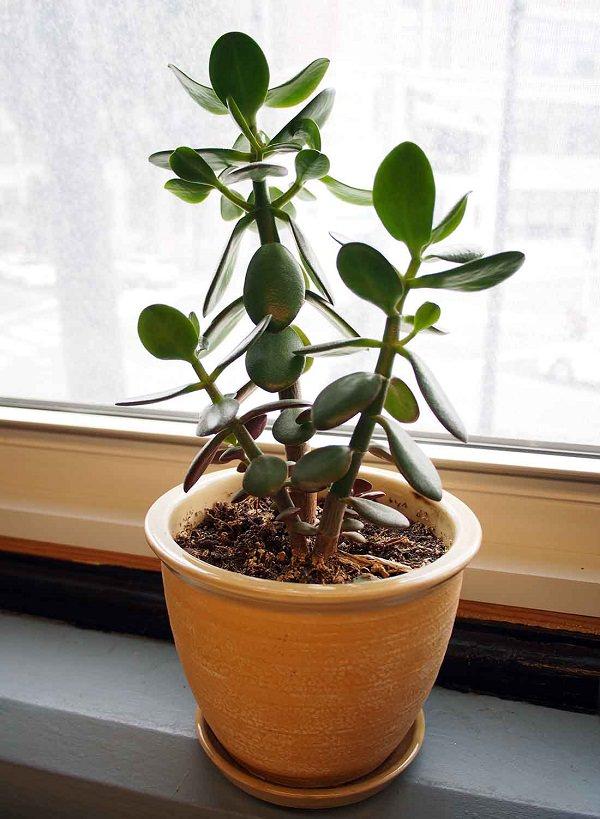
Jade plant is a succulent and is probably one of the best houseplants for beginners. When grown indoors, a jade plant can grow up to a size of a small shrub. Keep the plant in a spot that receives partial or indirect sunlight from having a healthy specimen.
9. Cast Iron Plant
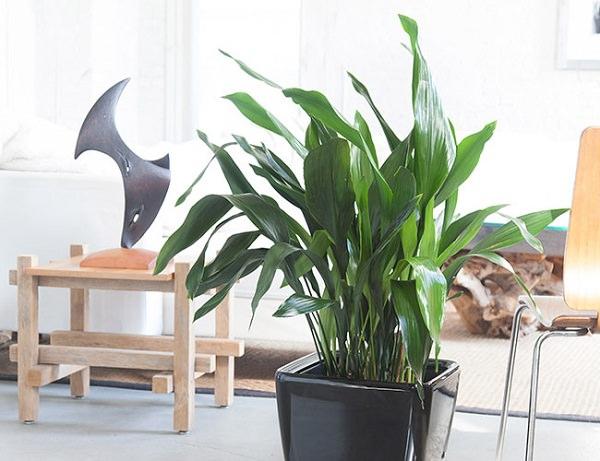
As the name suggest, one of the toughest plants that make it ideal for beginners. Cast-iron plant can withstands neglect, low light, low humidity, and a wide range of temperatures. It prefers moist soil.
10. Peperomia

Credit: Houseplants Expert
Another good plant for beginners is Peperomia. Peperomia is small striking houseplant that is available in different colors and shapes. Peperomia likes slightly moist soil and humidity but watering should be reduced in winter.
11. ZZ Plant
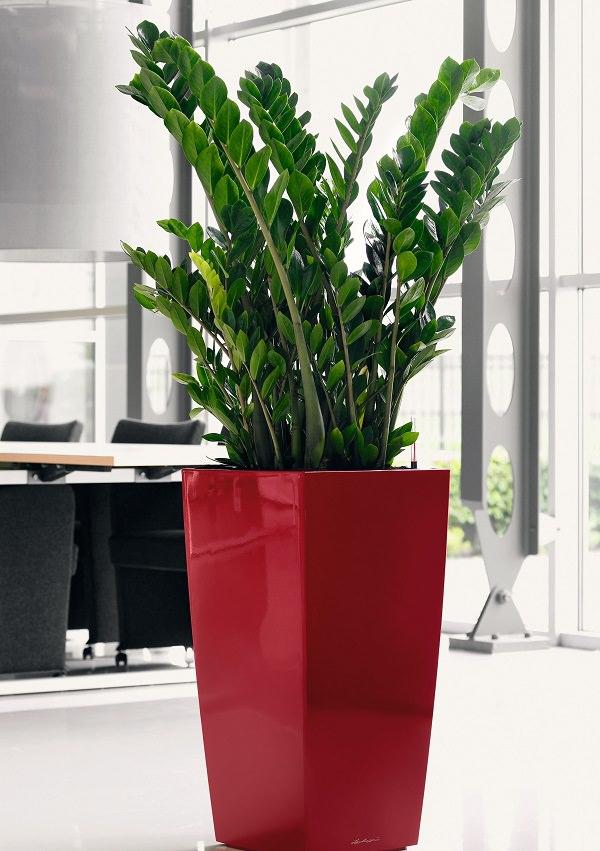
This super-tough plant is high resistant to adverse conditions like drought and low light. The plant prefers bright to moderate indirect light and well-drained soil. ZZ plant can do fine without fertilizer, but if you would like, you can fertilize the plant with half strength general fertilizer one to two times a year in the summer months.
12. Pothos (Devil’s Ivy)
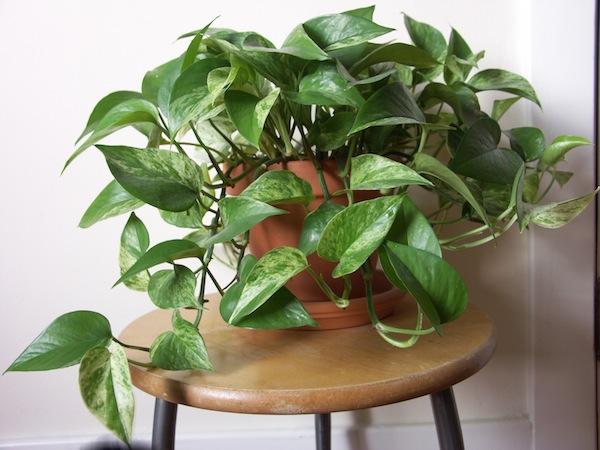
Plants of the pothos family are easy to grow and become great houseplants for beginners. This attractive and durable vine prefers bright indirect light and a draft free place. It can grow in low light and needs moist soil.
13. Dracaena
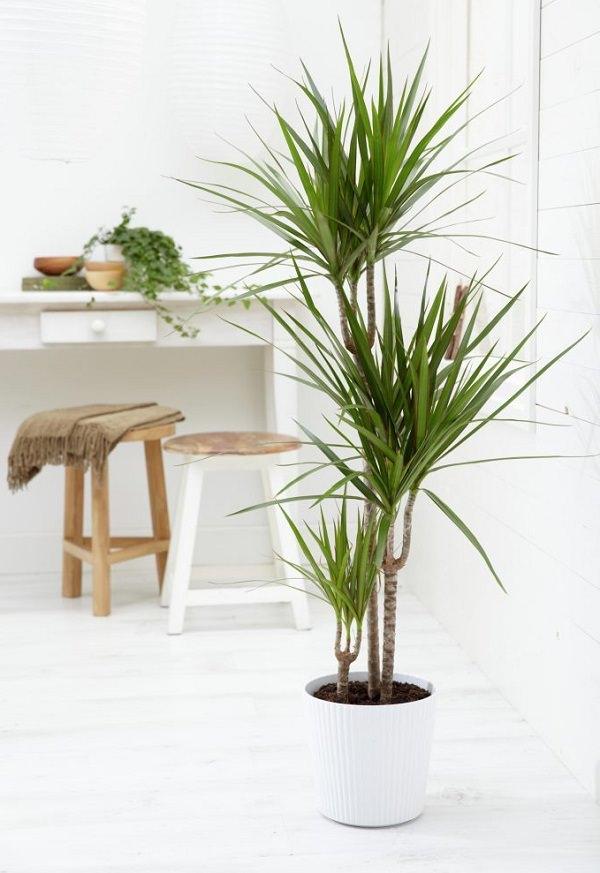
There are many varieties of Dracaena genus that are hardy houseplants, Dracaena marginata, Dracaena fragrans are among the most popular and easy to grow plants. This beautiful houseplant needs occasional pruning and regular watering. Keep the plant away from direct sun and avoid overwatering.
14. Bromeliads
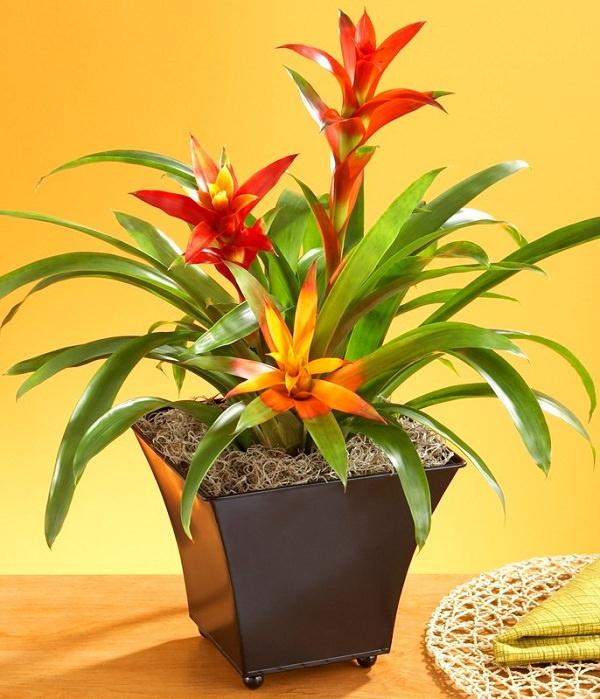
Bromeliad is a perfect plant to grow indoors, most of the varieties of this plant thrive easily indoors. Although it is difficult to make it bloom, there are many varieties that have beautiful foliage that makes an attractive display.
15. Rubber Plant
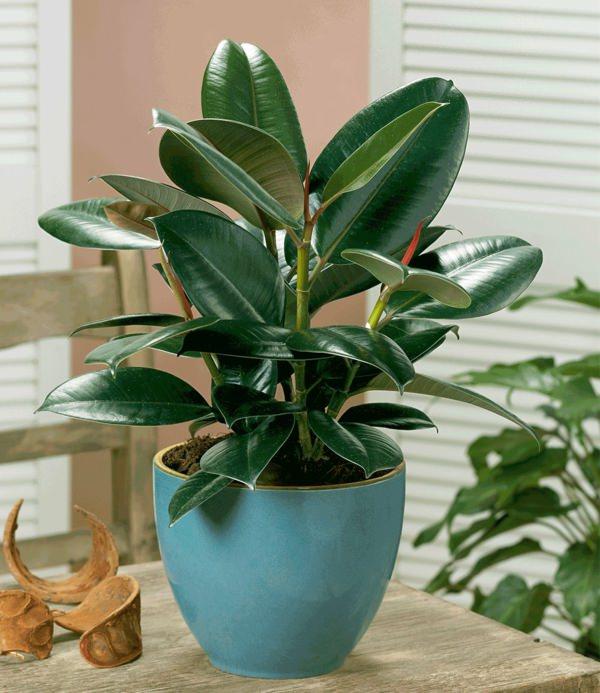
Rubber plant is a large houseplant that can become a focal point to any room. Low maintenance and easy to grow. Keep it in a well-lit position in your home and allow the soil to dry out between watering spells. Besides the ornamental aspect, rubber plant is also an air purifying plant.
Potted houseplants provide a lavish look and can be used to decorate the interior at low cost. Also, they create positive impact and many of them purify the air. But what you’ll do if you don’t have much knowledge about growing plants and the houseplants that are best to grow? Simple! Learn about these 15 Best Houseplants for Beginners! They are easy to grow and tolerate poor conditions.
1. Snake Plant

Snake plant is one of the best plants for the beginners. Easy to grow and hard to kill, it can be grown in low light and need to be watered occasionally. Snake plant also removes toxins from the air– All this makes it a perfect houseplant for beginners.
2. Heartleaf Philodendron

Philodendron scandens is extremely easy to grow and great for beginners. It needs a moderate amount of light and prefers the soil to dry out between watering spells.
3. Spider Plant

One of the most popular houseplants. Its popularity is due to its toughness and the ease of growing and maintenance. The plant can easily adapt to almost any condition. Keep the plant in a bright spot and maintain slight moisture in the soil and it will grow happily.
4. Peace Lily

The peace lily is among the easiest plants to grow indoors. It can tolerate a wide range of lighting conditions, and needs only moderate watering. With graceful curving leaves and white flower that rise up from the dark foliage, peace lily looks exotic and elegant.
5. English Ivy

English Ivy is very hardy and easy to grow. Keep the pot in a spot that receives bright indirect sun and plant it in a container that is wide and shallow rather than narrow and deep.
6. Succulents and Cactus

Succulents and cacti are ideal for those who forget to water and care for plants. They are very adaptable and can survive many adverse conditions.
They need to be placed on a bright spot and a well-drained soil with little water.
7. Lucky Bamboo

Lucky bamboo is not a bamboo, but a plant belongs to Dracaena genus. It is an easy-care houseplant. Just provide it abundant water and it’ll grow well even in indirect light. Protect the plant from cold drafts and provide iron fertilizer occasionally.
8. Jade Plant

Jade plant is a succulent and is probably one of the best houseplants for beginners. When grown indoors, a jade plant can grow up to a size of a small shrub. Keep the plant in a spot that receives partial or indirect sunlight from having a healthy specimen.
9. Cast Iron Plant

As the name suggest, one of the toughest plants that make it ideal for beginners. Cast-iron plant can withstands neglect, low light, low humidity, and a wide range of temperatures. It prefers moist soil.
10. Peperomia

Credit: Houseplants Expert
Another good plant for beginners is Peperomia. Peperomia is small striking houseplant that is available in different colors and shapes. Peperomia likes slightly moist soil and humidity but watering should be reduced in winter.
11. ZZ Plant

This super-tough plant is high resistant to adverse conditions like drought and low light. The plant prefers bright to moderate indirect light and well-drained soil. ZZ plant can do fine without fertilizer, but if you would like, you can fertilize the plant with half strength general fertilizer one to two times a year in the summer months.
12. Pothos (Devil’s Ivy)

Plants of the pothos family are easy to grow and become great houseplants for beginners. This attractive and durable vine prefers bright indirect light and a draft free place. It can grow in low light and needs moist soil.
13. Dracaena

There are many varieties of Dracaena genus that are hardy houseplants, Dracaena marginata, Dracaena fragrans are among the most popular and easy to grow plants. This beautiful houseplant needs occasional pruning and regular watering. Keep the plant away from direct sun and avoid overwatering.
14. Bromeliads

Bromeliad is a perfect plant to grow indoors, most of the varieties of this plant thrive easily indoors. Although it is difficult to make it bloom, there are many varieties that have beautiful foliage that makes an attractive display.
15. Rubber Plant

Rubber plant is a large houseplant that can become a focal point to any room. Low maintenance and easy to grow. Keep it in a well-lit position in your home and allow the soil to dry out between watering spells. Besides the ornamental aspect, rubber plant is also an air purifying plant.
0
2
文章
扭扭
2017年05月23日

The correct selection of plants plays an important role in the design and functioning of vertical living wall gardens. In this article, we show a selection of the best plants for vertical gardening.
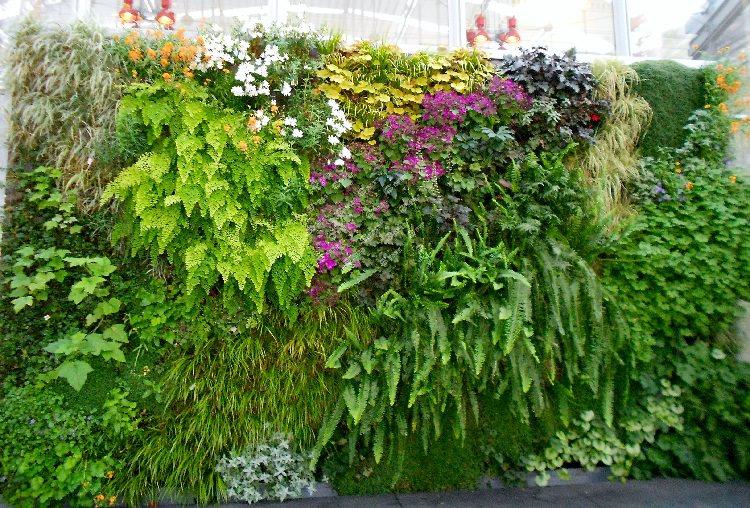
Best Plants For Vertical Garden
Not all plants adapt well to vertical gardening. They must have certain important characteristics for proper development and growth.
Ferns
They are one of the garden plants that are preferred for their adaptability and humidity resistance. Ferns are easy to grow and they cover the area quickly. You can grow sword fern, blue star fern, bird’s nest fern, they are easiest. Ferns will generally grow downward, so you’ll need to grow other covering plants with them too.
Bromeliads
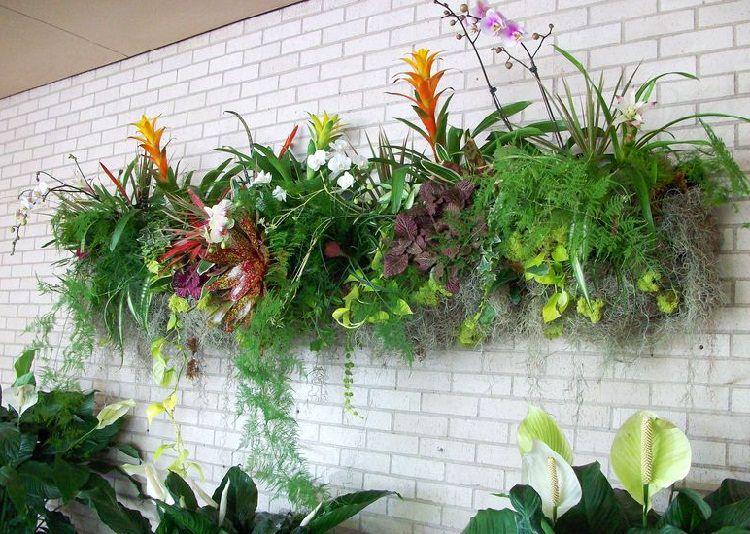
Most bromeliads have shallow roots and they need little space to grow this makes them ideal plants for vertical gardens. Their colorful leaves and long lasting flowers can be a good addition to your vertical garden.
Begonias
If you are hanging your living wall in a place that receives some sun then growing begonias is a good idea.
Hostas
This beautiful plant with variegated foliage is used as a groundcover in gardens. For a shady site, this evergreen plant is suitable for a vertical garden.
Lipstick Plant
Growing lipstick plant is easy. It doesn’t require deep soil to grow so it can thrive in a vertical wall. You can also grow it indoors.
Must Read: How to Make a Vertical Wall Planter
Succulents
Succulents are the most used plants for vertical gardens due to their incredible adaptability and resistance to fluctuation in temperatures and climatic variations. Plants like the string of pearls, echeveria, crassula and sedum can be considered.
Air Plants (Epiphyte)
Such plants do not need soil to thrive, they grow naturally on other plants, which makes them perfect for growing in vertical wall gardens. Tillandsias, aechmea, vriesea are a few examples.
Vines
Low maintenance vines such as pothos, ivies, philodendrons, rosary vine and wandering jew can be grown vertical planters easily. They are low maintenance and even thrive in indirect sunlight.

Best Plants For Vertical Garden
Not all plants adapt well to vertical gardening. They must have certain important characteristics for proper development and growth.
Ferns
They are one of the garden plants that are preferred for their adaptability and humidity resistance. Ferns are easy to grow and they cover the area quickly. You can grow sword fern, blue star fern, bird’s nest fern, they are easiest. Ferns will generally grow downward, so you’ll need to grow other covering plants with them too.
Bromeliads

Most bromeliads have shallow roots and they need little space to grow this makes them ideal plants for vertical gardens. Their colorful leaves and long lasting flowers can be a good addition to your vertical garden.
Begonias
If you are hanging your living wall in a place that receives some sun then growing begonias is a good idea.
Hostas
This beautiful plant with variegated foliage is used as a groundcover in gardens. For a shady site, this evergreen plant is suitable for a vertical garden.
Lipstick Plant
Growing lipstick plant is easy. It doesn’t require deep soil to grow so it can thrive in a vertical wall. You can also grow it indoors.
Must Read: How to Make a Vertical Wall Planter
Succulents
Succulents are the most used plants for vertical gardens due to their incredible adaptability and resistance to fluctuation in temperatures and climatic variations. Plants like the string of pearls, echeveria, crassula and sedum can be considered.
Air Plants (Epiphyte)
Such plants do not need soil to thrive, they grow naturally on other plants, which makes them perfect for growing in vertical wall gardens. Tillandsias, aechmea, vriesea are a few examples.
Vines
Low maintenance vines such as pothos, ivies, philodendrons, rosary vine and wandering jew can be grown vertical planters easily. They are low maintenance and even thrive in indirect sunlight.
1
0
文章
lenny
2017年05月23日
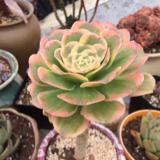
If you have a limited space and you want to create a small rose garden there then growing roses in containers is the best option for you.

Blooming roses are among the most beautiful ornamental plants that can be grown in the garden. It is hardly surprising that many rose lovers that have limited space also desire to grow them. Fortunately, growing roses in containers on a balcony, patio or terrace is possible, this way you can create a small rose garden. Except large variety of roses, you can grow all type of roses in containers.
Choose Roses Wisely
Roses are one of the most diverse plants on our planet. There are 14, 000 varieties of roses of which some can withstand the – 40 F extreme cold temperature then there are some rose varieties suitable for tropics that bear up to 110 F and still blooms. Choose roses wisely, according to your climate.
You should also consider the space you have, decide whether you want to grow a small rose garden or just a few roses.
Type of Roses to Consider
Miniature Roses
Miniature Roses are comparatively easy to grow than all other rose types, they are simply the mini version of large roses and are ideal balcony roses, and good for roofs and patios. You can also grow them in hanging baskets and railing planters. On a balcony, you can also grow miniature climbing roses such as red cascade, to use up your vertical space. Miniature Roses produces small flowers of about 1”-2” inch size in red, yellow, pink, white, peach, orange and many other colors. Generally, the bushes grow to no more than 18 inches in height.
Hybrid Teas
If you like large roses, grow hybrid tea roses. They flower less but phenomenal. One flower on a long, straight and upright stem. Hybrid Tea Roses can be as tall as 6 feet. Each bloom can be up to 5″ in diameter. Hybrid Tea Roses are one of the world’s most popular types of roses due to their color and large blooms.
Floribunda
Floribunda roses produce a cluster of flowers on top of each stem, their blooms are smaller in compare to tea roses. These roses can grow up to 3 feet tall.
Patio Roses
Patio roses are undemanding small bushes, which grows between 18 to 24 inches tall. They have a compact growing habit and thrive well in containers.
To learn more about rose varieties for containers read this post.

Roses Must have Suitable Containers
The size of the container should be medium to large to grow rose bushes. Larger varieties require extensive, deep pot with a minimum diameter of 40 cm, with large drainage holes in the bottom. On the other hand, low growing, medium to small sized roses can be grown in containers with a diameter of 25 – 30 cm.
Don’t overlook the look of containers, potted rose plants look more beautiful if you choose a handsome container for them.
While choosing container look at their bottom for drainage holes, good drainage is essential for roses. If there is insufficient drainage, make some holes.
When and How to Plant Roses to Make a Small Rose Garden
Best time for planting roses is spring to early summer. After purchasing roses transplant them as soon as possible to new, larger pots as they usually are sold in very small containers.
For the USDA zones 9 – 11 and other subtropical and tropical parts, rose can be planted from any time between fall (autumn) to winter.
If you have bought bare root roses you should keep their roots submerged for an hour or two in the water, making them absorb the moisture, this will make them easier to adopt in a new place.
Then put on damp root ball of your rose plant into the pot. While planting, ensure that rose placed in soil just deep as it used to grow in the previous pot.
Water well the freshly planted roses and for a few days place them in a sheltered place that receives only a few hours of morning sun, later on, move the containers to the position that is sufficiently bright and receives the sun at least for 7 hours as no roses, in the long run, can tolerate shade.
Throughout the season, roses in containers should be watered deeply and moderately because they do not tolerate desiccation.
After about 2 to 3 weeks of planting, roses are ready to be fertilized. One thing you should know that roses are heavy feeders. Fertilize roses using the special rose mix fertilizer, which you can buy from a garden center, you can also fertilize them with any all-purpose fertilizer. Application of manure and compost also helps the rose plants.
Overwintering Roses
The main advantage of growing plants on a balcony is that it remains comparatively warmer than regular gardens. Still you should do some things to warm the pots and plants, do heavy mulching with organic matter and protect them from the cool air.
In very low temperatures in winters, keep your potted roses indoors.
For tropics it is opposite, you’ll need to care roses in summer. Cool weather varieties will die itself, so grow rose varieties that are suitable for tropics and save them from scorching the sun when it is overheadTips

Except North facing, you can grow roses on every type of balcony.
If you want to grow roses on South facing balcony, protect them from afternoon sun (especially in warm climates)
Every spring or in the beginning of growing season replace the potting soil or at least replace the top layer with compost or manure.
Always cut the faded flowers, this stimulates the growth of new buds.
Read more on rose care tips

Blooming roses are among the most beautiful ornamental plants that can be grown in the garden. It is hardly surprising that many rose lovers that have limited space also desire to grow them. Fortunately, growing roses in containers on a balcony, patio or terrace is possible, this way you can create a small rose garden. Except large variety of roses, you can grow all type of roses in containers.
Choose Roses Wisely
Roses are one of the most diverse plants on our planet. There are 14, 000 varieties of roses of which some can withstand the – 40 F extreme cold temperature then there are some rose varieties suitable for tropics that bear up to 110 F and still blooms. Choose roses wisely, according to your climate.
You should also consider the space you have, decide whether you want to grow a small rose garden or just a few roses.
Type of Roses to Consider

Miniature Roses
Miniature Roses are comparatively easy to grow than all other rose types, they are simply the mini version of large roses and are ideal balcony roses, and good for roofs and patios. You can also grow them in hanging baskets and railing planters. On a balcony, you can also grow miniature climbing roses such as red cascade, to use up your vertical space. Miniature Roses produces small flowers of about 1”-2” inch size in red, yellow, pink, white, peach, orange and many other colors. Generally, the bushes grow to no more than 18 inches in height.
Hybrid Teas
If you like large roses, grow hybrid tea roses. They flower less but phenomenal. One flower on a long, straight and upright stem. Hybrid Tea Roses can be as tall as 6 feet. Each bloom can be up to 5″ in diameter. Hybrid Tea Roses are one of the world’s most popular types of roses due to their color and large blooms.
Floribunda
Floribunda roses produce a cluster of flowers on top of each stem, their blooms are smaller in compare to tea roses. These roses can grow up to 3 feet tall.
Patio Roses
Patio roses are undemanding small bushes, which grows between 18 to 24 inches tall. They have a compact growing habit and thrive well in containers.
To learn more about rose varieties for containers read this post.

Roses Must have Suitable Containers
The size of the container should be medium to large to grow rose bushes. Larger varieties require extensive, deep pot with a minimum diameter of 40 cm, with large drainage holes in the bottom. On the other hand, low growing, medium to small sized roses can be grown in containers with a diameter of 25 – 30 cm.
Don’t overlook the look of containers, potted rose plants look more beautiful if you choose a handsome container for them.
While choosing container look at their bottom for drainage holes, good drainage is essential for roses. If there is insufficient drainage, make some holes.
When and How to Plant Roses to Make a Small Rose Garden
Best time for planting roses is spring to early summer. After purchasing roses transplant them as soon as possible to new, larger pots as they usually are sold in very small containers.
For the USDA zones 9 – 11 and other subtropical and tropical parts, rose can be planted from any time between fall (autumn) to winter.
If you have bought bare root roses you should keep their roots submerged for an hour or two in the water, making them absorb the moisture, this will make them easier to adopt in a new place.
Then put on damp root ball of your rose plant into the pot. While planting, ensure that rose placed in soil just deep as it used to grow in the previous pot.
Water well the freshly planted roses and for a few days place them in a sheltered place that receives only a few hours of morning sun, later on, move the containers to the position that is sufficiently bright and receives the sun at least for 7 hours as no roses, in the long run, can tolerate shade.
Throughout the season, roses in containers should be watered deeply and moderately because they do not tolerate desiccation.
After about 2 to 3 weeks of planting, roses are ready to be fertilized. One thing you should know that roses are heavy feeders. Fertilize roses using the special rose mix fertilizer, which you can buy from a garden center, you can also fertilize them with any all-purpose fertilizer. Application of manure and compost also helps the rose plants.
Overwintering Roses
The main advantage of growing plants on a balcony is that it remains comparatively warmer than regular gardens. Still you should do some things to warm the pots and plants, do heavy mulching with organic matter and protect them from the cool air.
In very low temperatures in winters, keep your potted roses indoors.
For tropics it is opposite, you’ll need to care roses in summer. Cool weather varieties will die itself, so grow rose varieties that are suitable for tropics and save them from scorching the sun when it is overheadTips

Except North facing, you can grow roses on every type of balcony.
If you want to grow roses on South facing balcony, protect them from afternoon sun (especially in warm climates)
Every spring or in the beginning of growing season replace the potting soil or at least replace the top layer with compost or manure.
Always cut the faded flowers, this stimulates the growth of new buds.
Read more on rose care tips
3
0
文章
安小宝
2017年05月23日


Square foot gardening is most often used for growing veggies, herbs and greens in a small space. It’s a simple concept that cuts down on gardening chores, saves money, water and seed, and grows healthier plants that are easily harvested when you want. Basically, square foot gardening is the theory that instead of planting in rows, you build a grid of one foot squares, fill with lightweight soil, and manage crop rotation by simply replanting an empty square whenever you harvest. We love this take on square foot gardening (above & below) from ‘Art and Appetite‘.

Benefits of gardening this way?
You can grow a lot more in a much smaller space.
Instead of sowing seeds thickly though out a row, you only need 2-3 seeds per square to grow one plant that doesn’t need the thinning that rows require.
Watering is more direct, therefore you waste less.
Weeds are easy to control, as they are in a controlled space, lightweight soil and easily accessible.
Fertilizing becomes easier, and less is used, again because of the controlled space.
It looks more attractive, and less chaotic than the typical veggie garden.
The plants are healthier due to crop rotation that happens though the natural progression of the squares, and better air circulation.
Having the plants close together allows you to spot and treat pest infestations easily.
You can build and grow a square foot garden right on top of even hard clay soil.
Convinced? Here are the easy steps to share square foot garden success!
Build a bottomless box, 4×4 feet square.
Place the box onto any surface. Since this will be a raised garden technique and the plants grow quickly in a short season, you won’t need more than one foot square of soil per plant. Basically, that means it does not matter what kind of soil is below the box.
Fill the box with a lightweight planting mix. Hardcore square foot gardeners will suggest that a blend of 1/3 compost, 1/3 vermiculite and 1/3 peat is the best mix. However, I have had luck with any good quality planting mix. Do NOT use soil from your yard. It will compact, and not provide a healthy base for your plants
Mark out a one foot square grid system. You can do this with stakes and string, wood slats, or simply decorative stones to mark the “lines”. It is simply a guide for you to know where to plant.

Here is a view of how ‘Our Daily Legacy‘ marked out their grid. Great tips there as well!

Plant 2-3 seeds or one transplant into each grid space for larger plants, up to 6 plants or more each grid space for smaller plants, like leaf lettuce.. Remember to plant the taller plants on the north or east side of the box so they won’t shade all the shorter plants. Here is a chart from ‘Atlantis Hydroponics‘ that shows an idea of how many can fit into each grid space, based on what you are planting.

Water gently, and fertilize as you would any vegetables or herbs, according to their needs.
When plants are ready for harvest, replant into that grid space. However, always replant a different type of plant than what was there before. This creates a natural “Crop rotation” and helps prevent disease. ‘It’s on the Tip of My Tongue‘ created this 4′ x 10’ box with a planting diagram of what they planted where.

Enjoy fresh vegetables and herbs! A couple of things to note…
You can make a larger box than 4×4 feet, but make sure it is in one foot increments, and no deeper than 4 feet to make care of the plants easier. 4×8 and 4×12 are common.
Use a material to build the box that is safe to grow edibles in.
Do not walk in your square foot garden, as this will compact the soil, preventing air and water from freely getting to the roots. This is one of the keys of square foot gardening success!
You can plant pretty things in here too! Especially blooming companion plants, like marigolds. But really, sky is the limit, even cutting flowers can be grown in a square foot garden!
This garden is from ‘Jungle Taming‘, and shows decorative plants mixed with herbs and veggies in a 4×4 box.

That’s all there is to it! Have you grown a square foot garden? Share your experience in comments!
1
1


